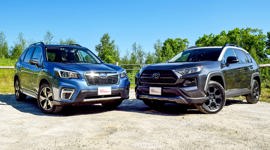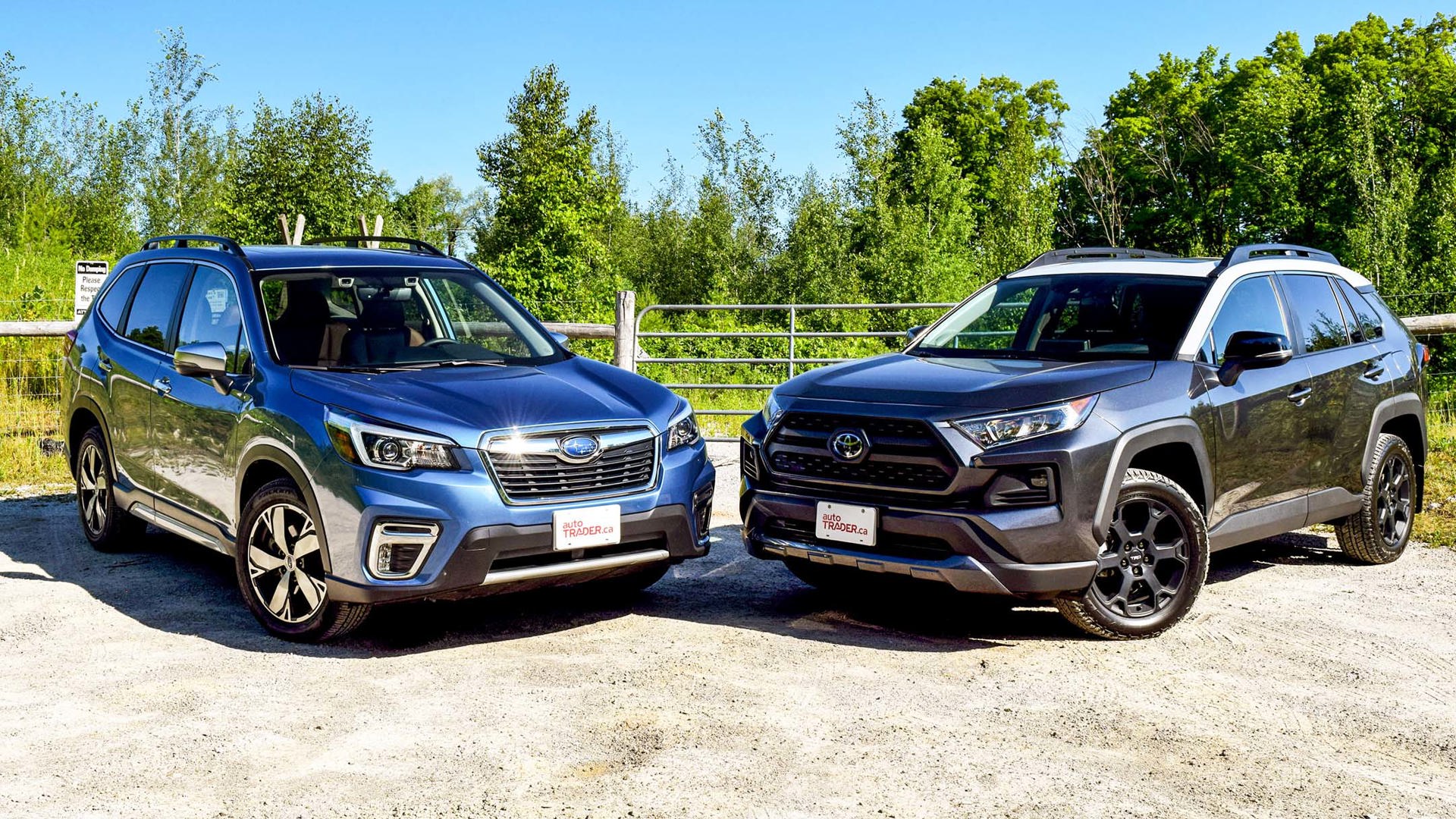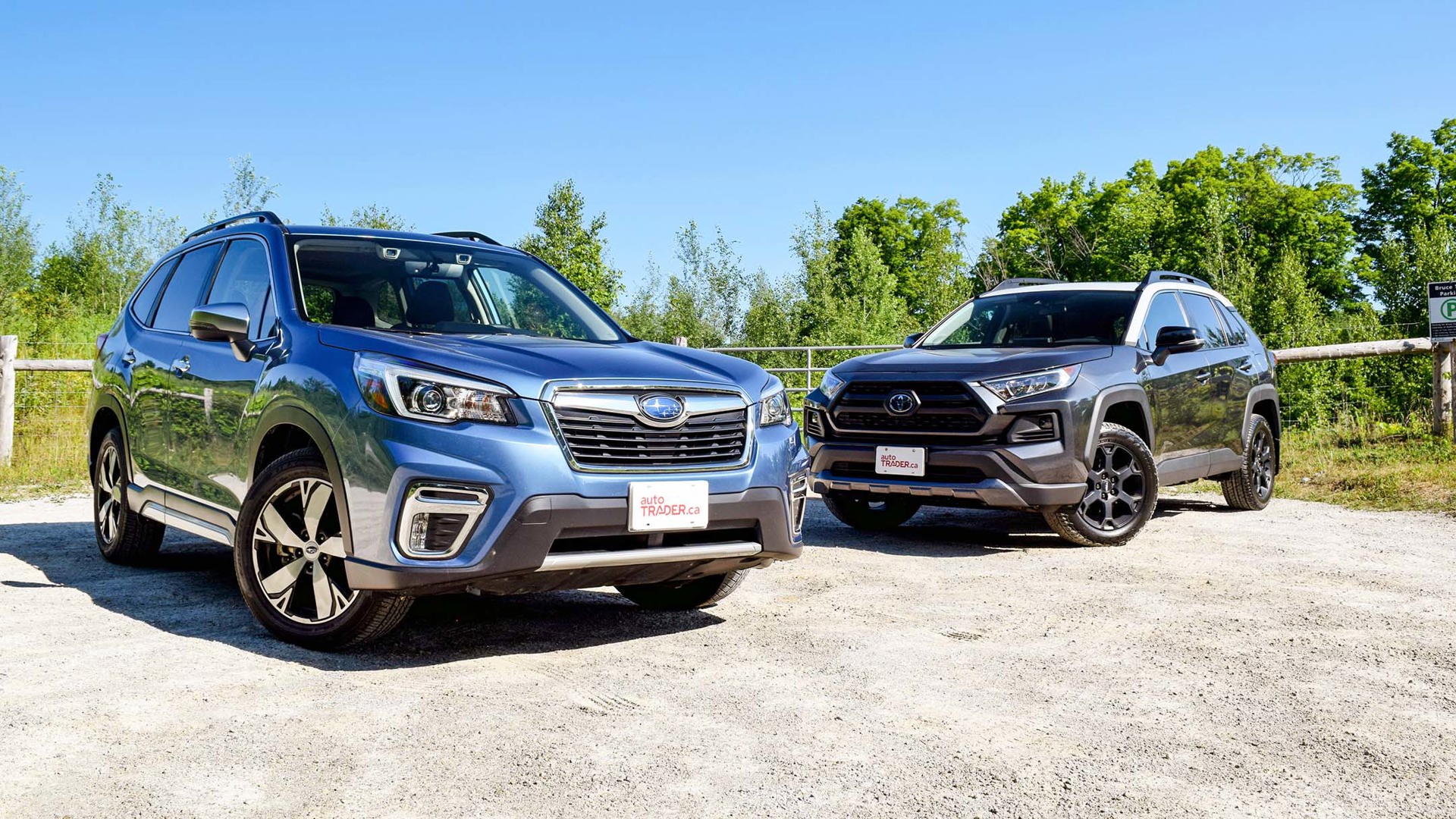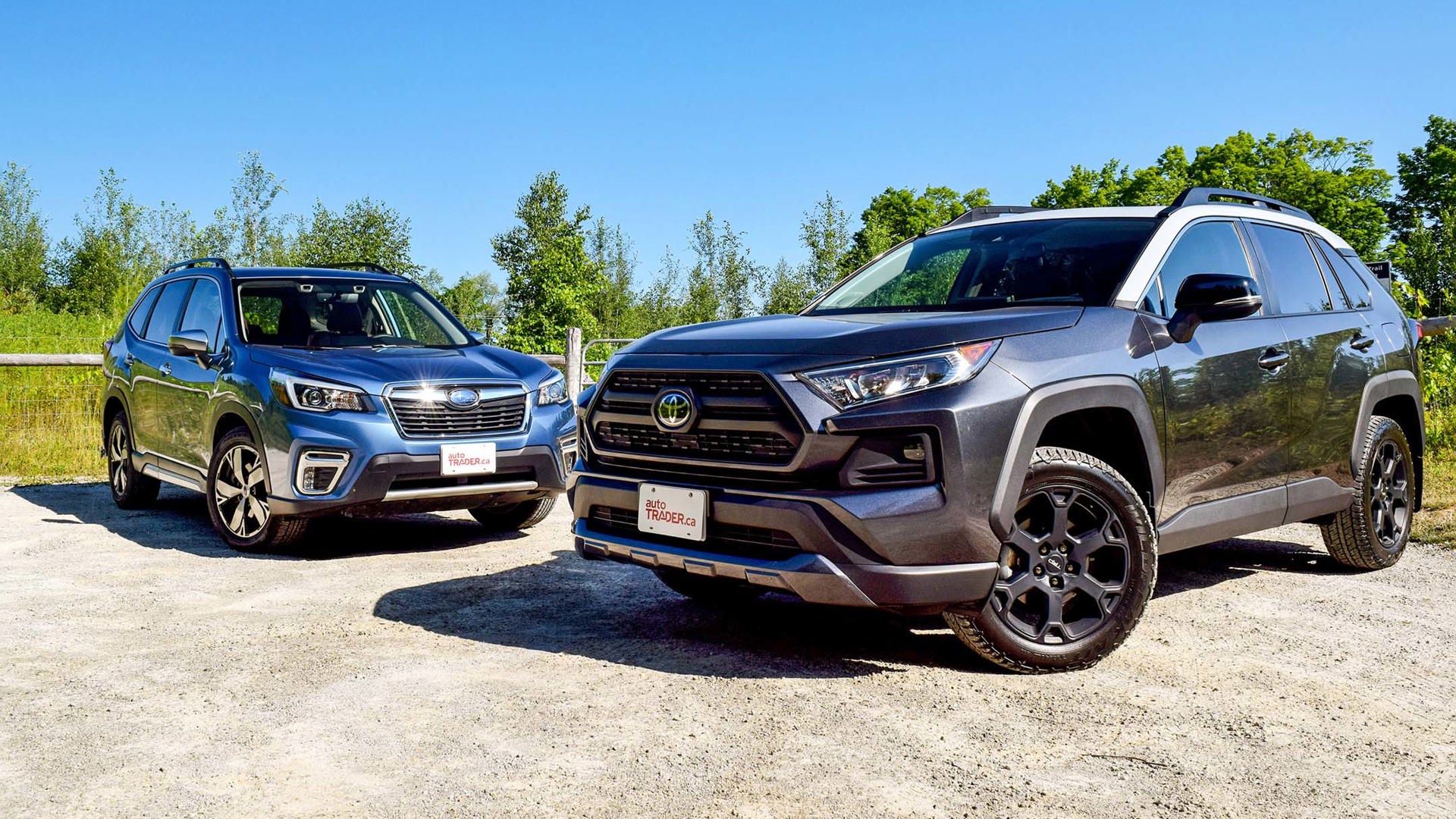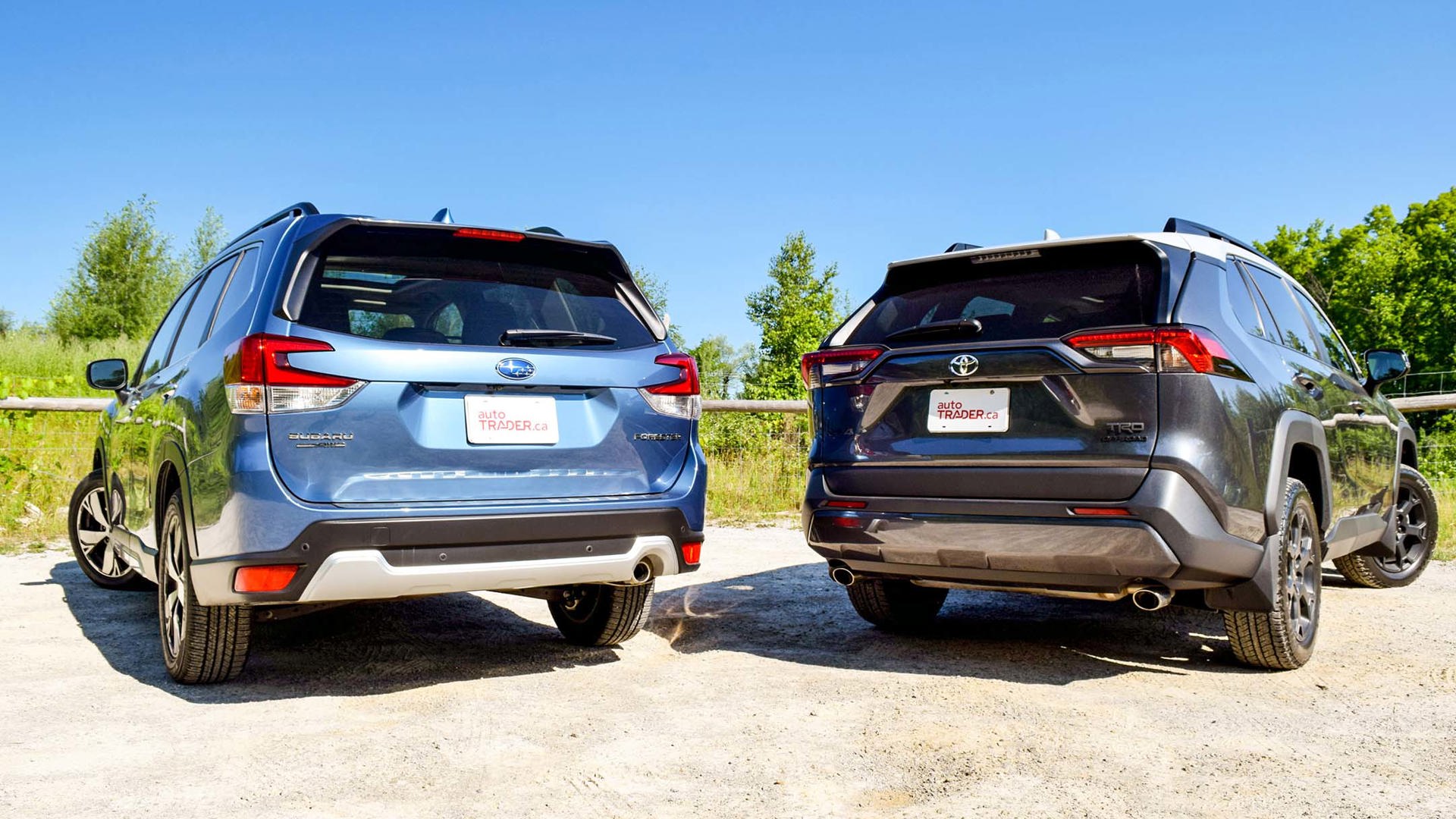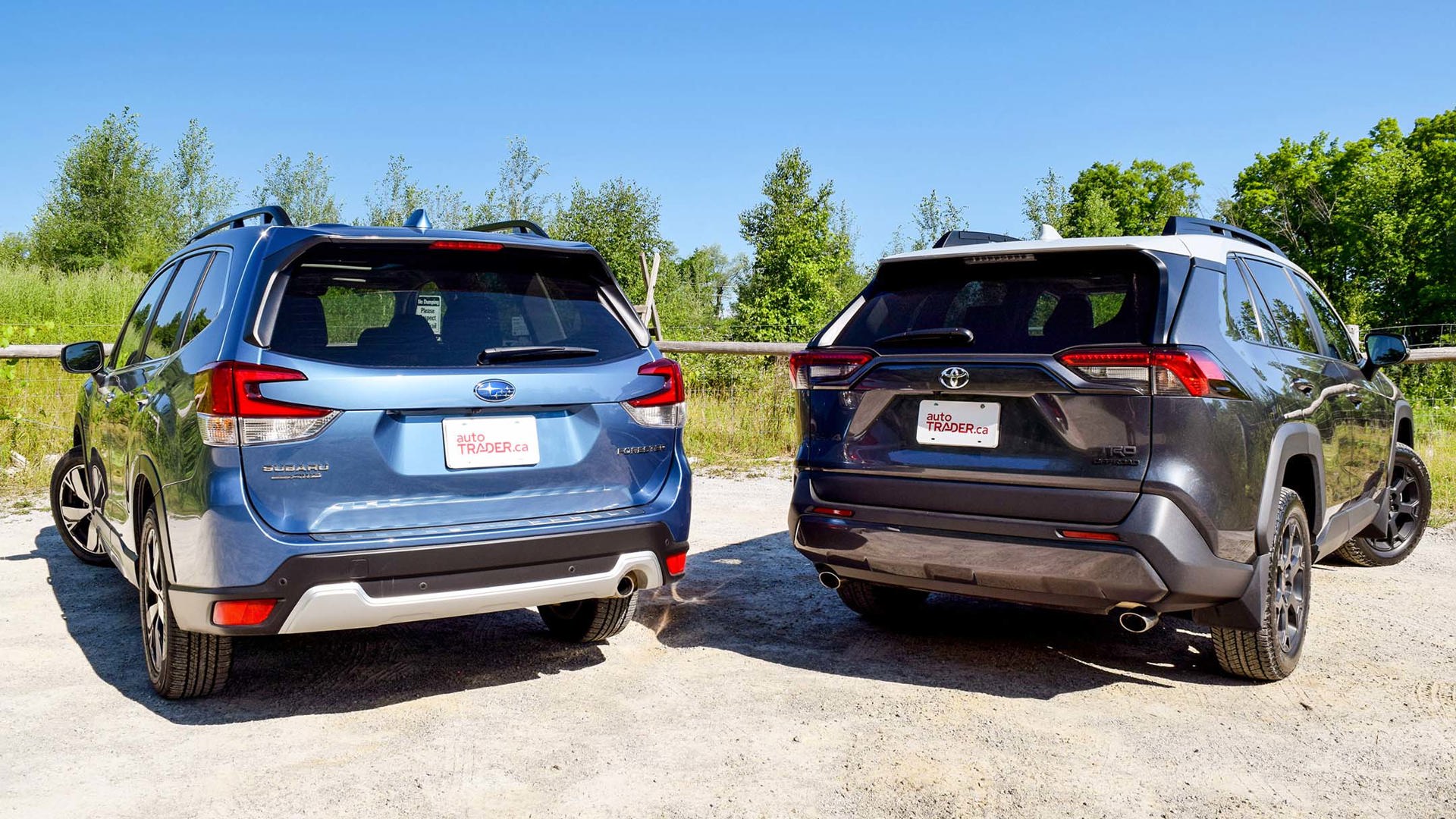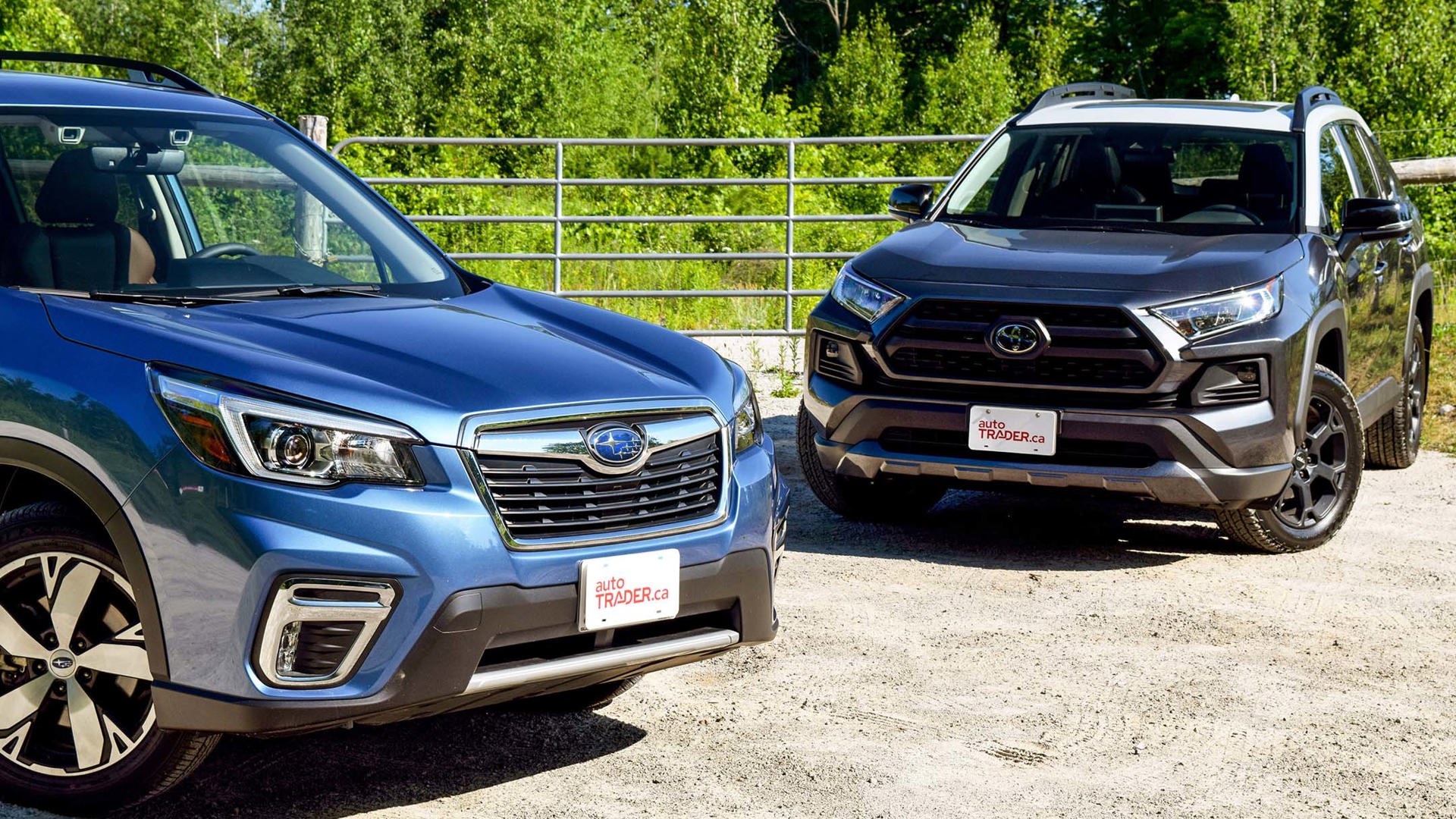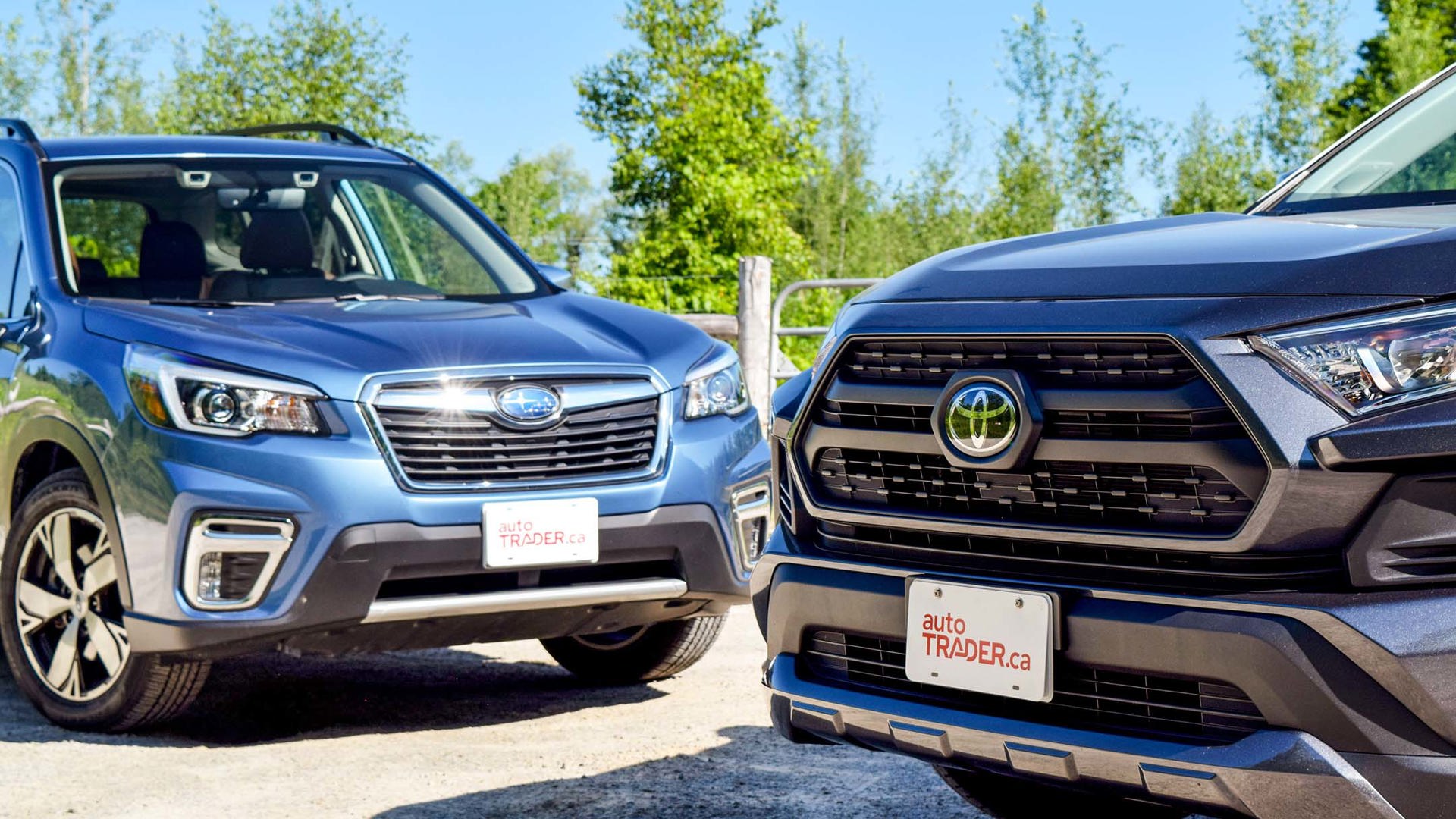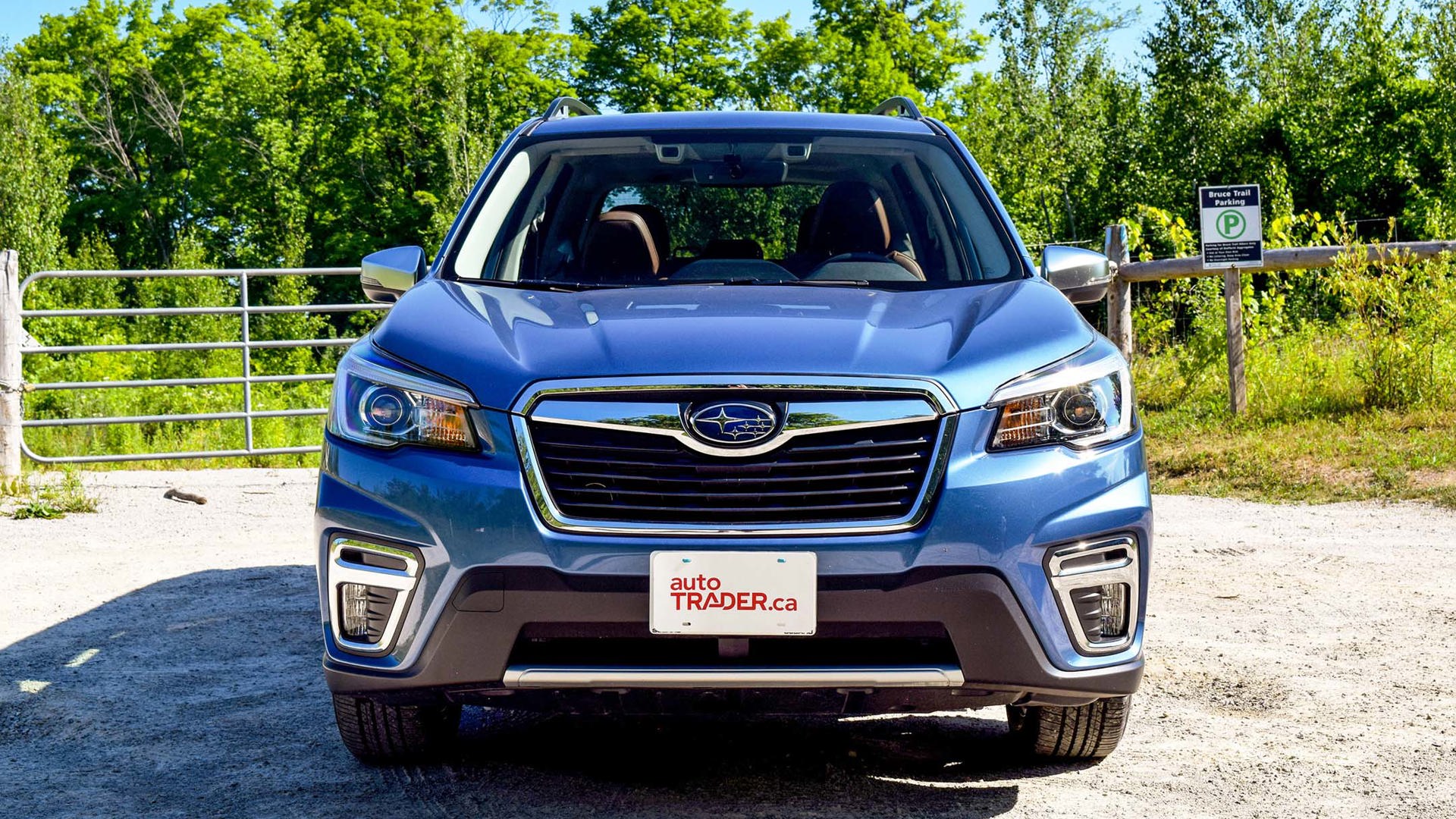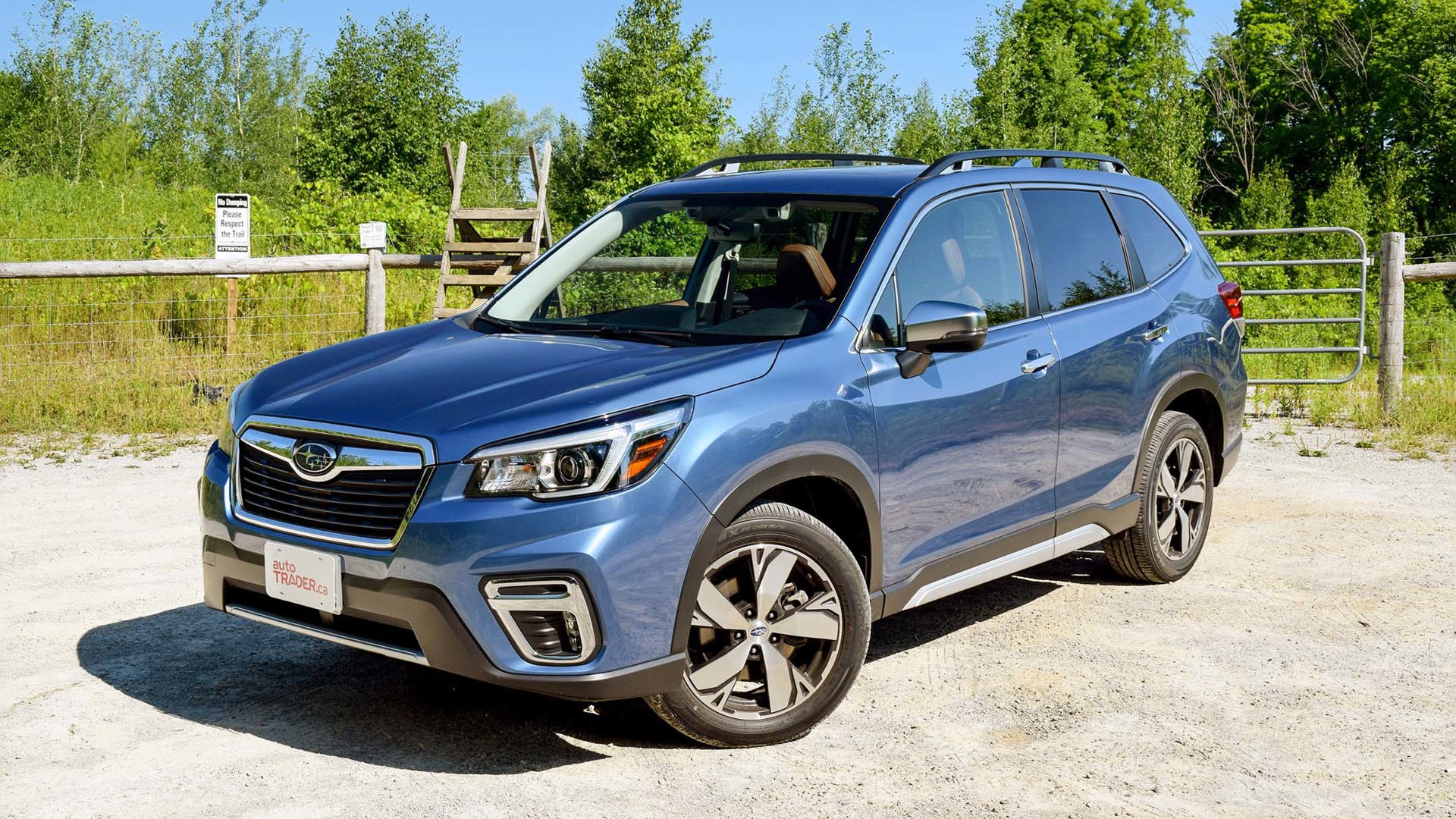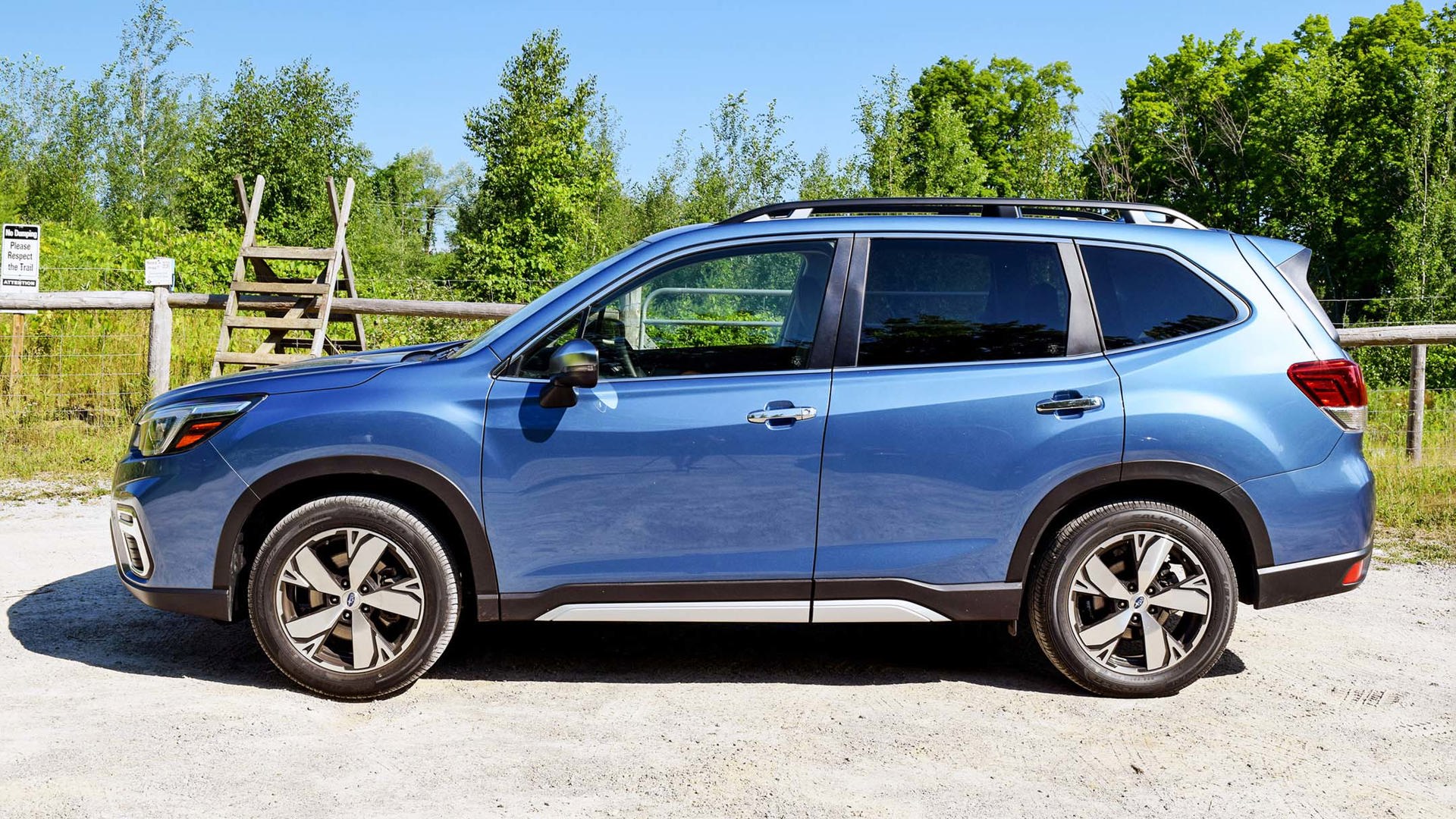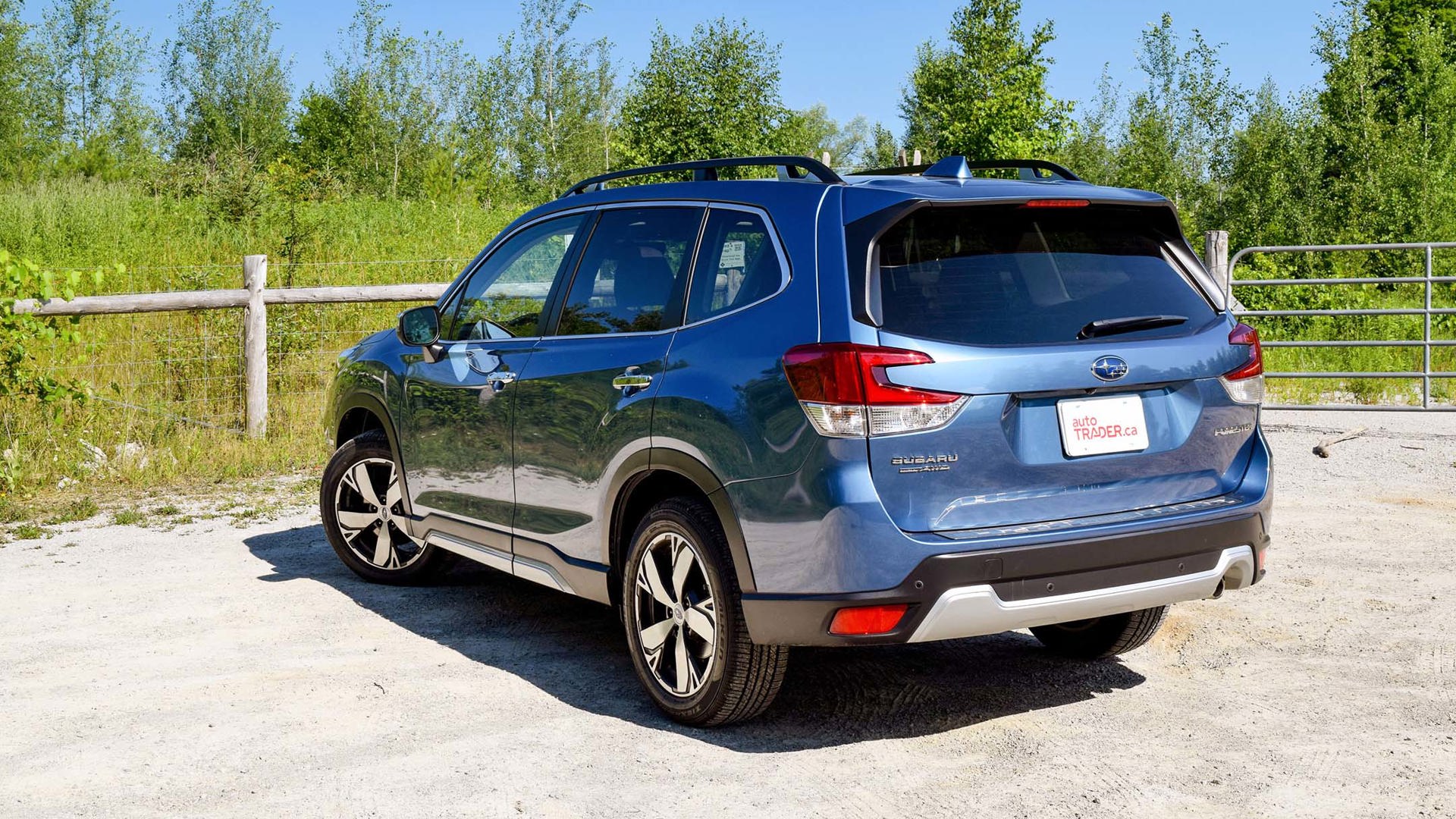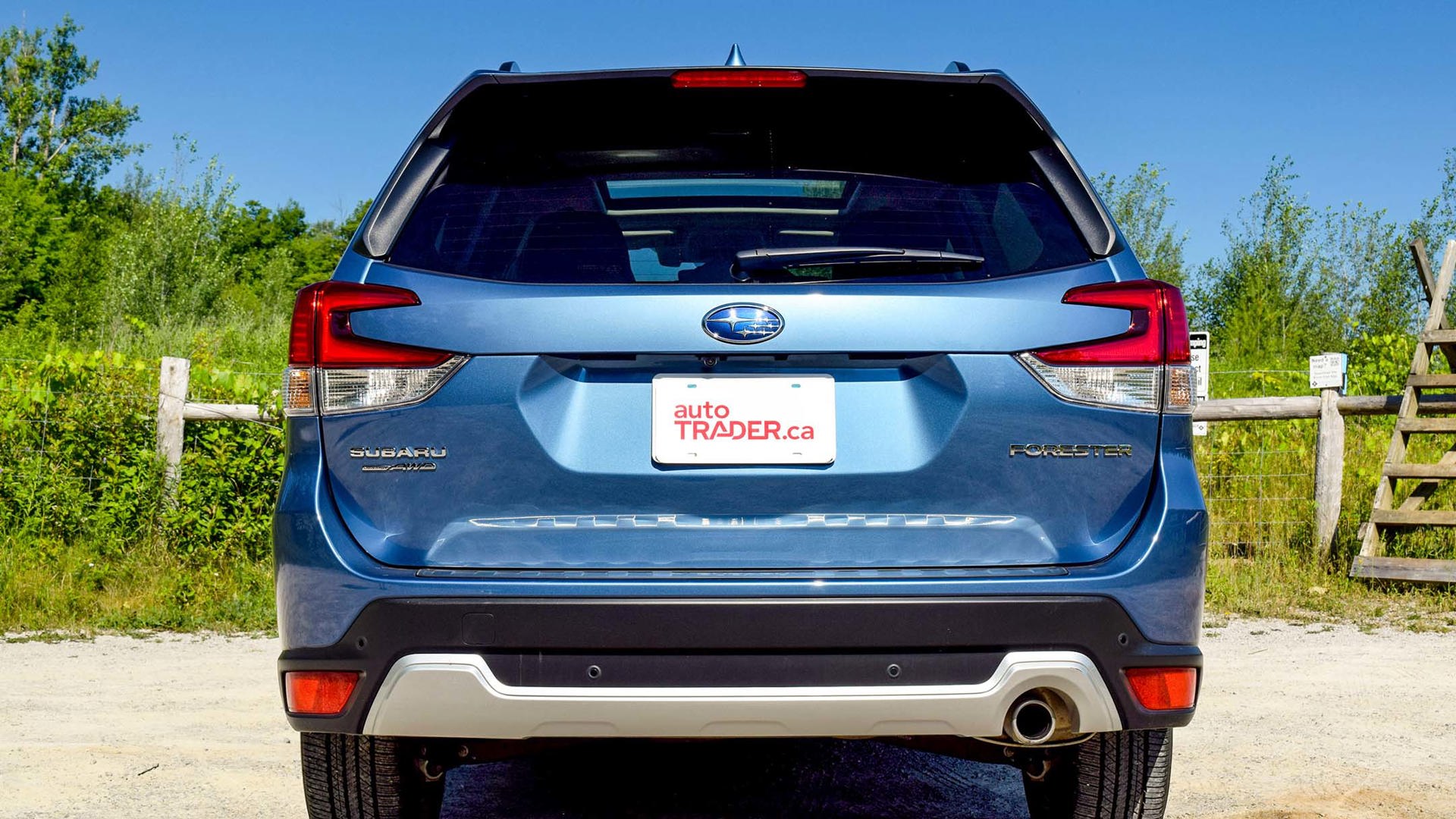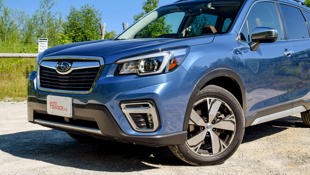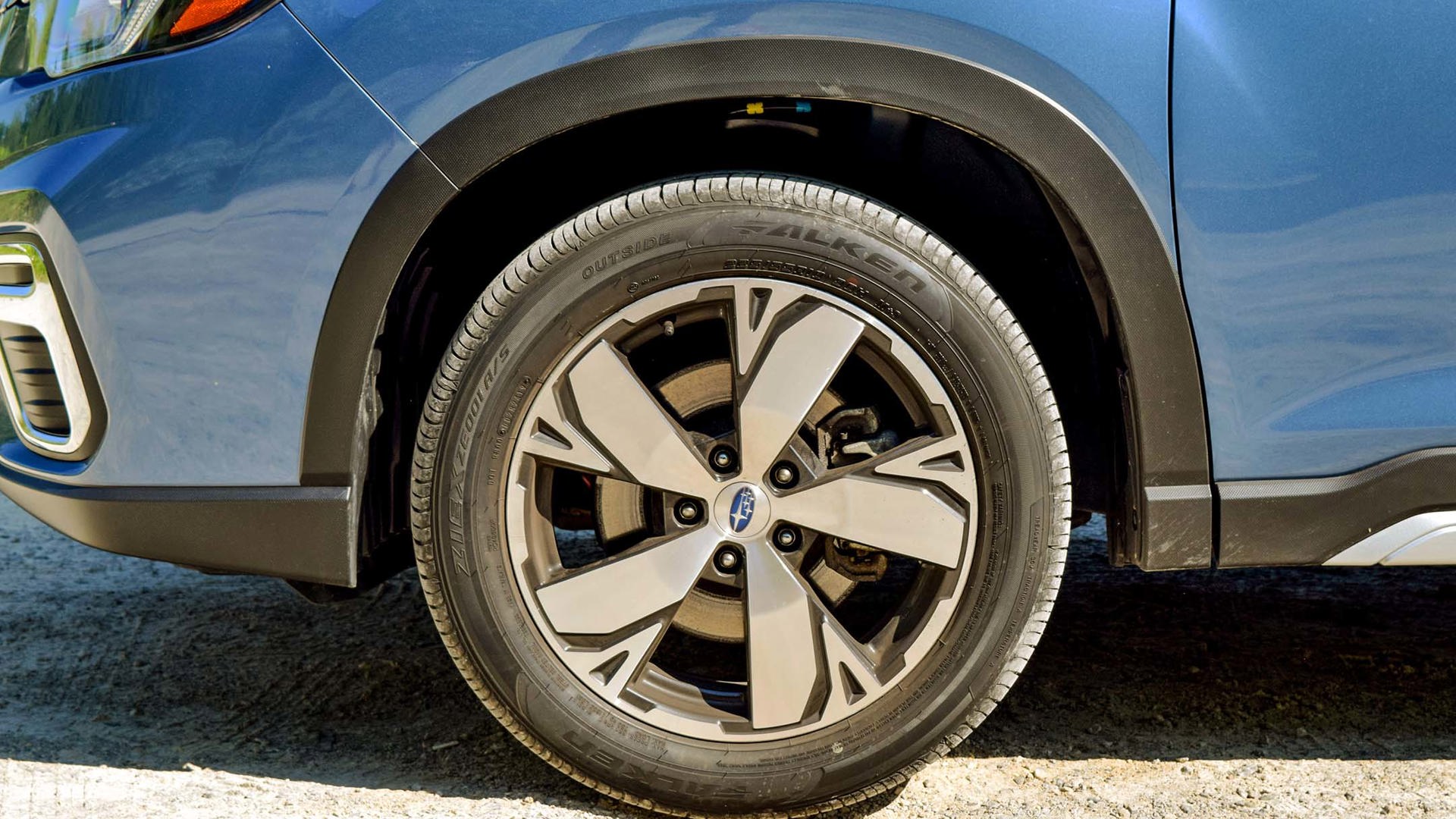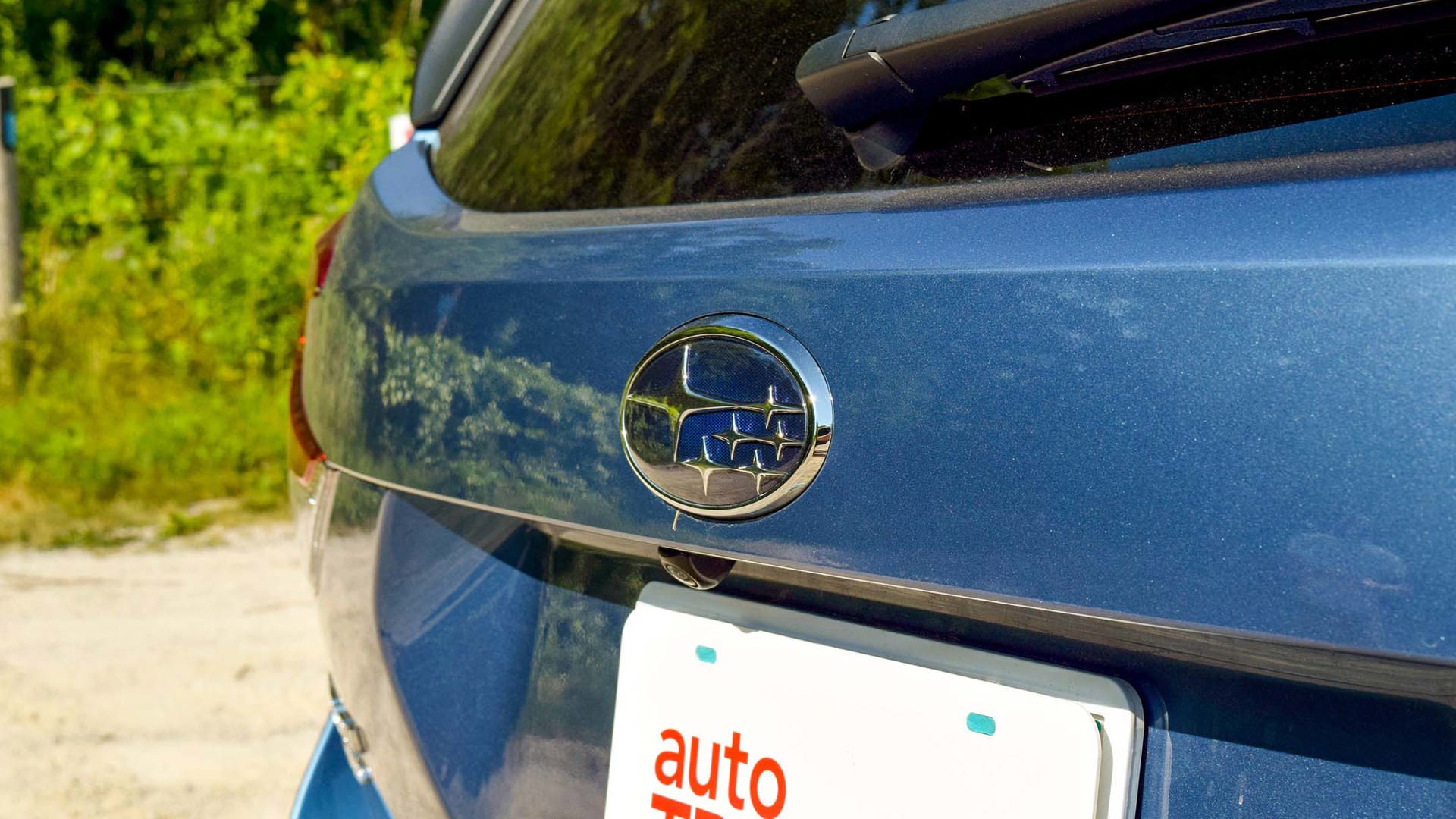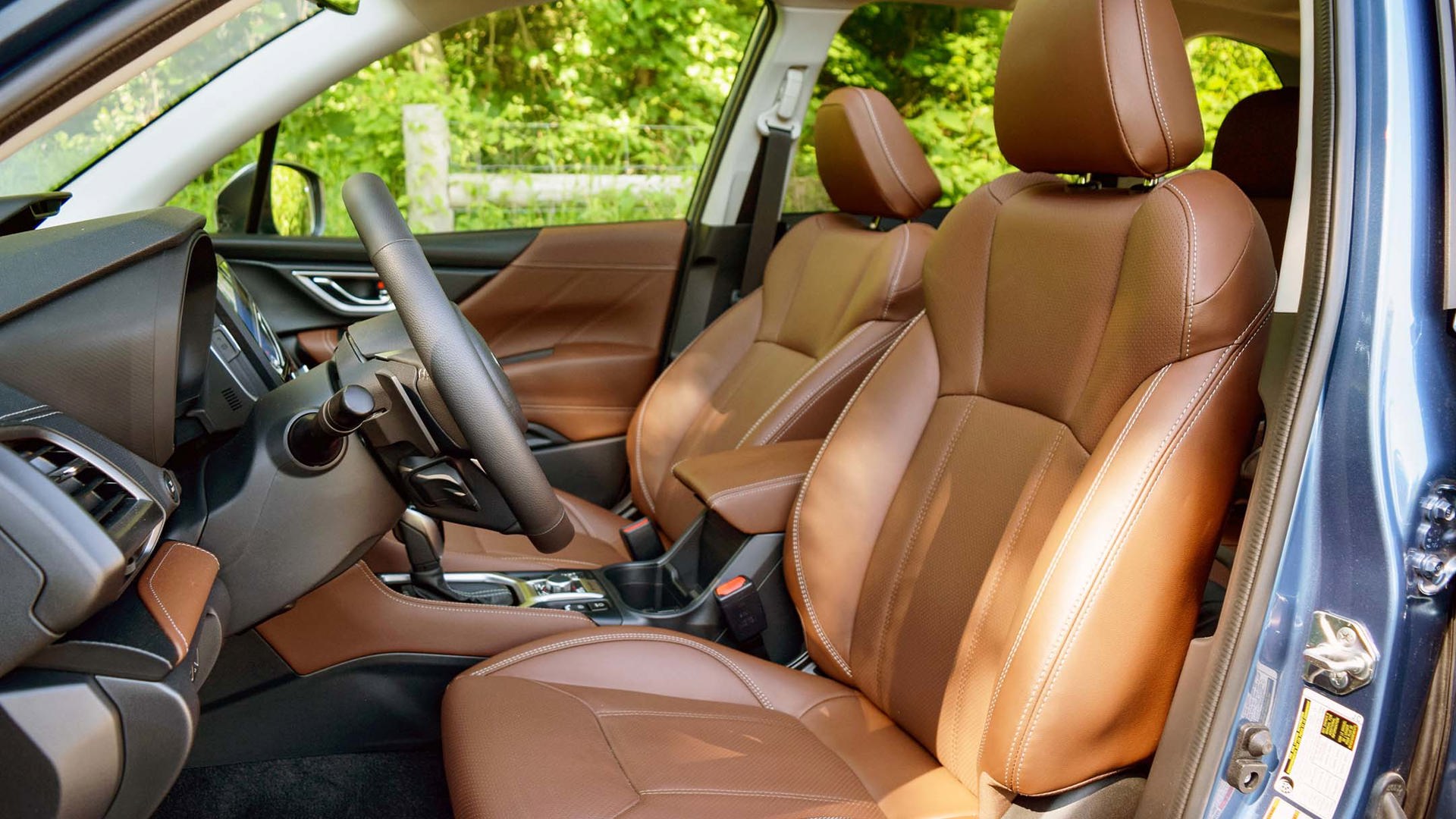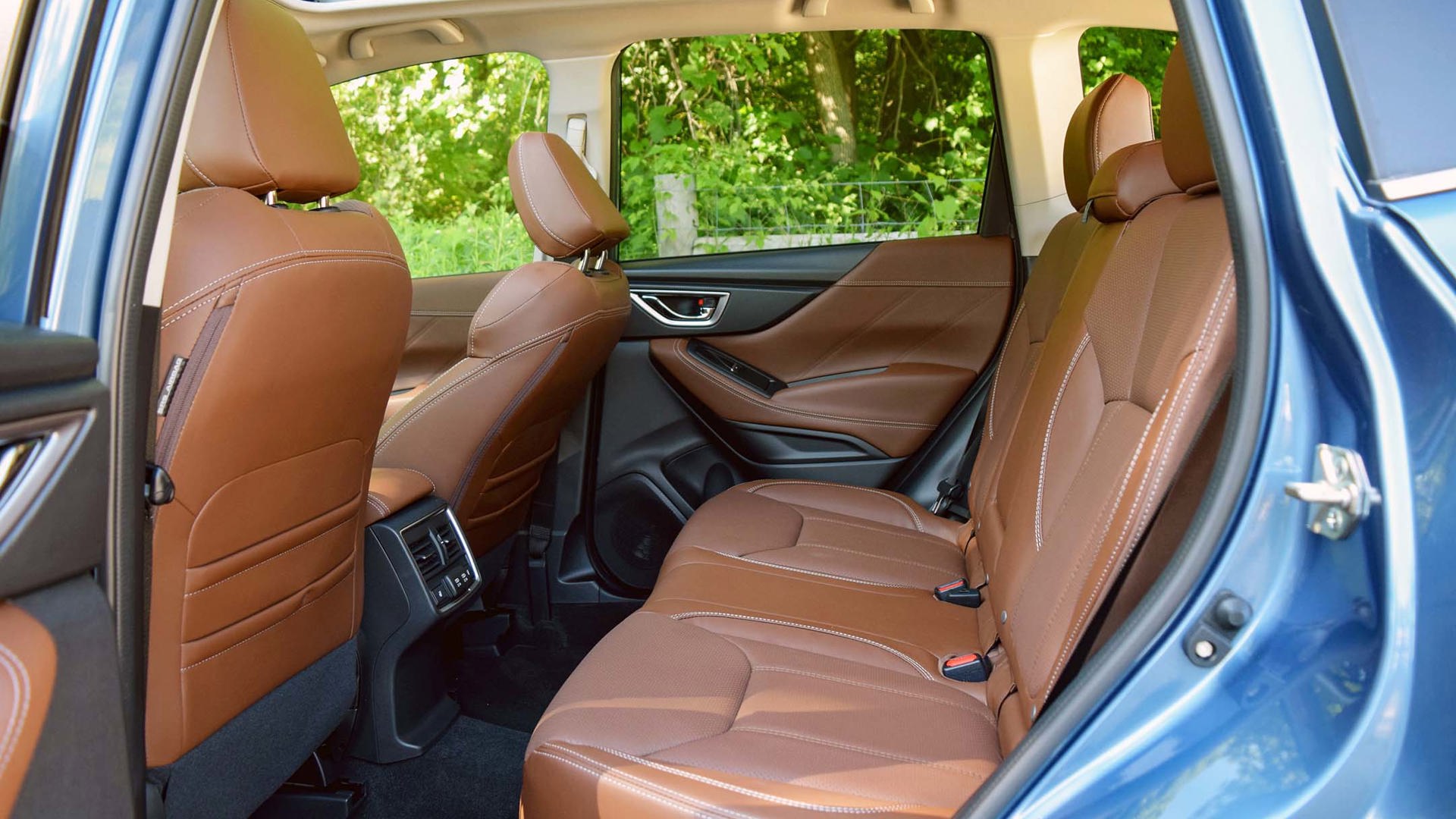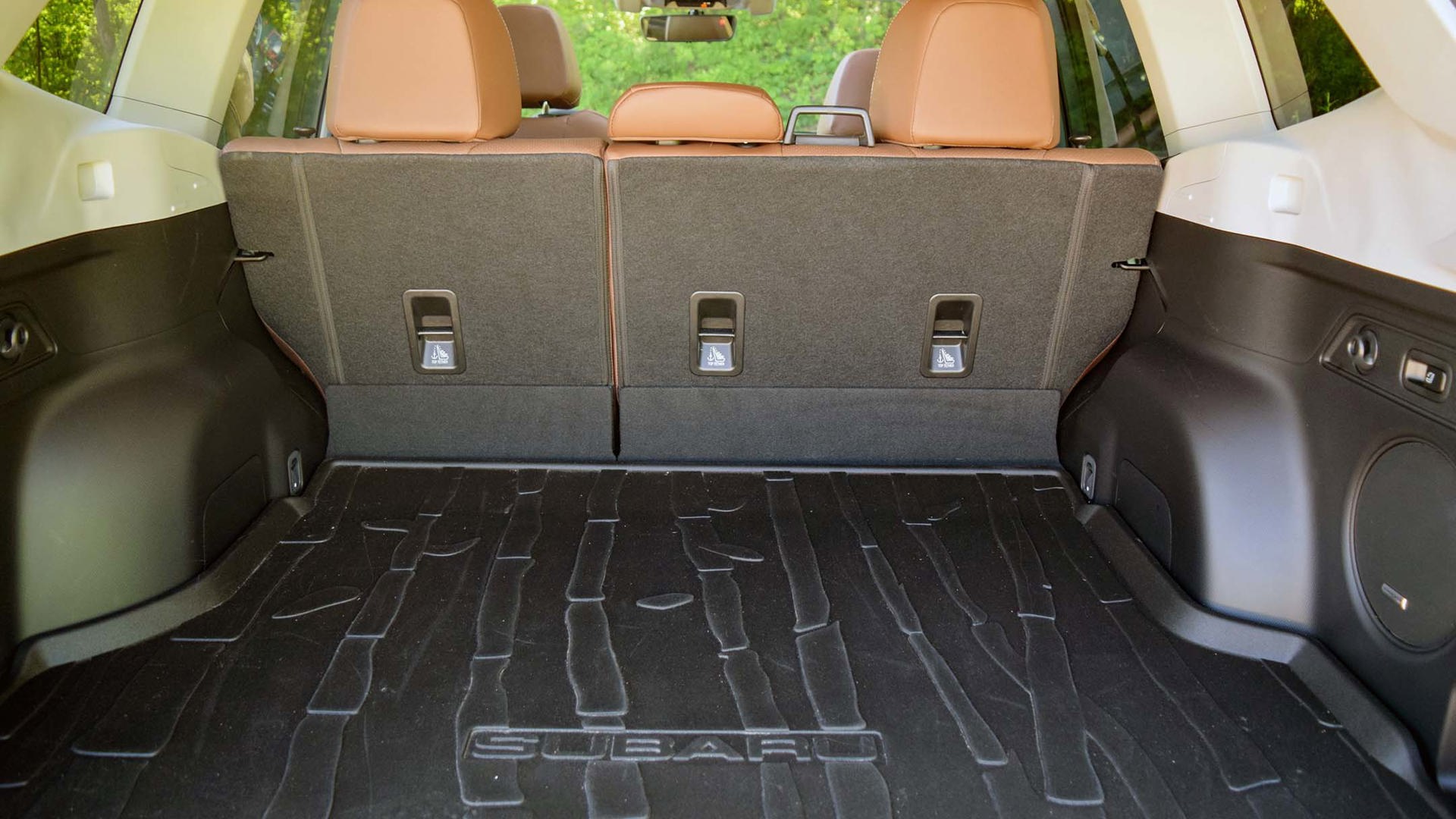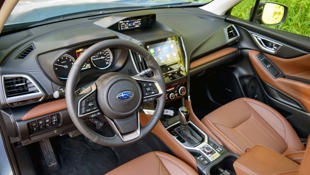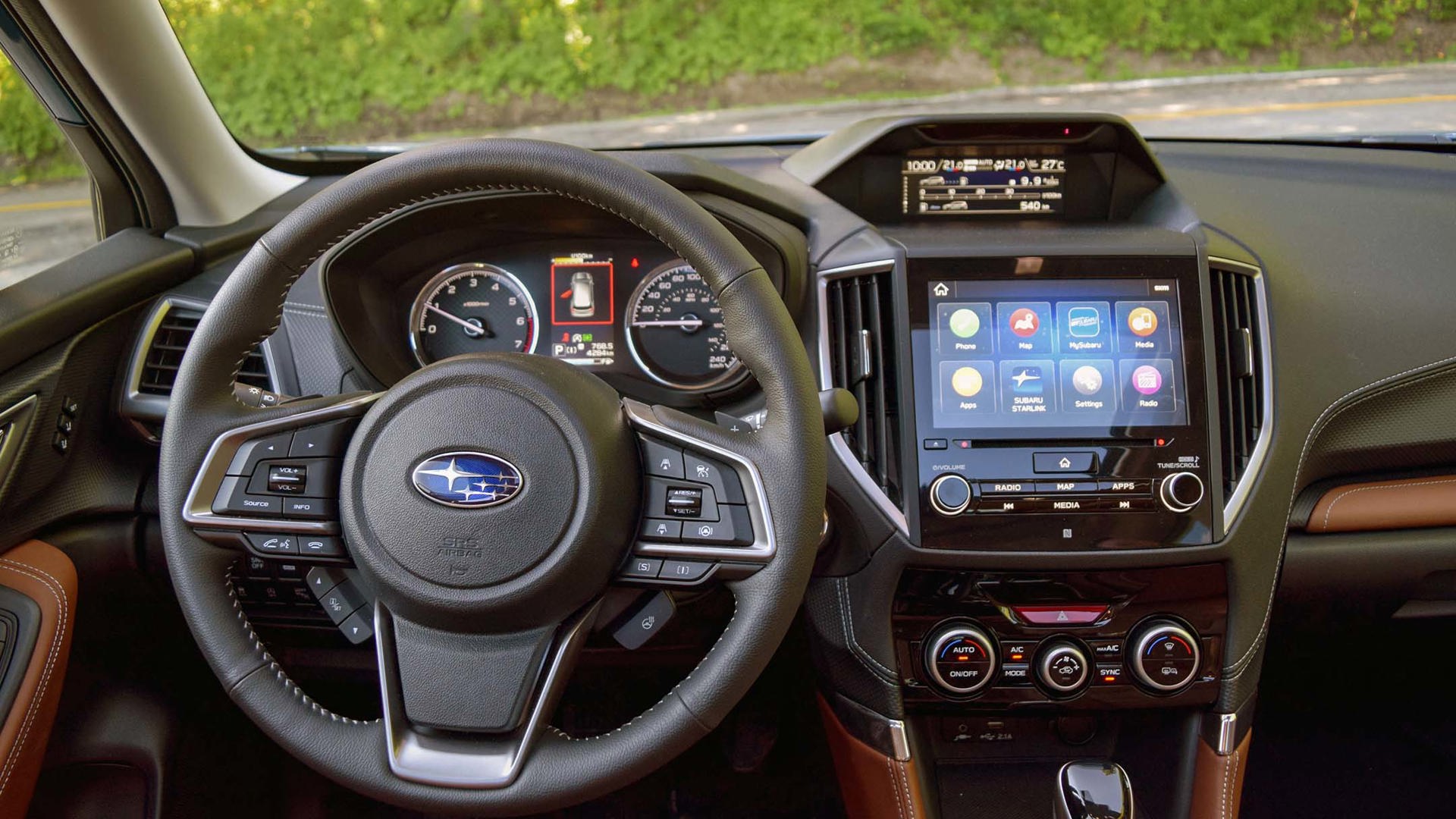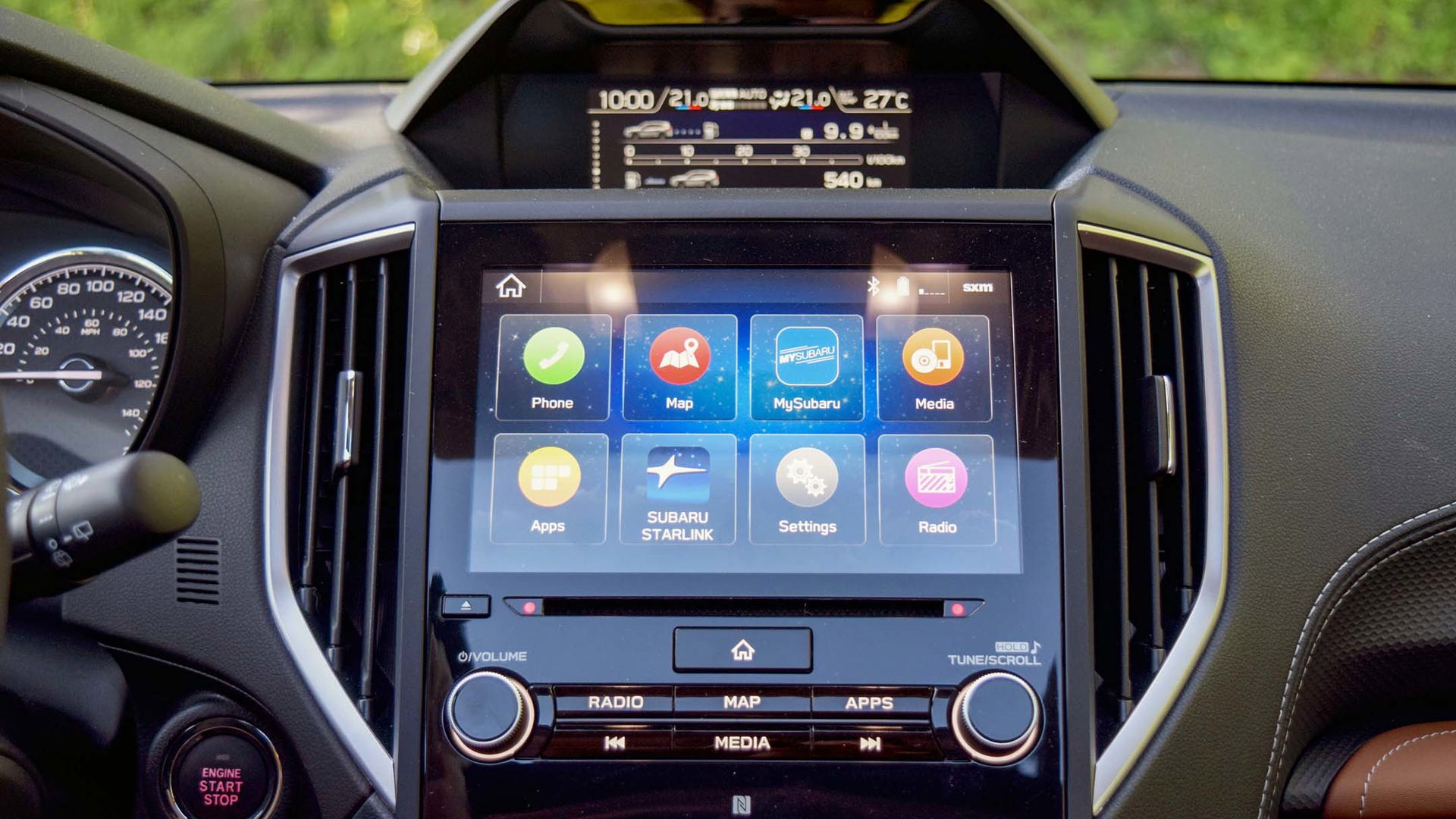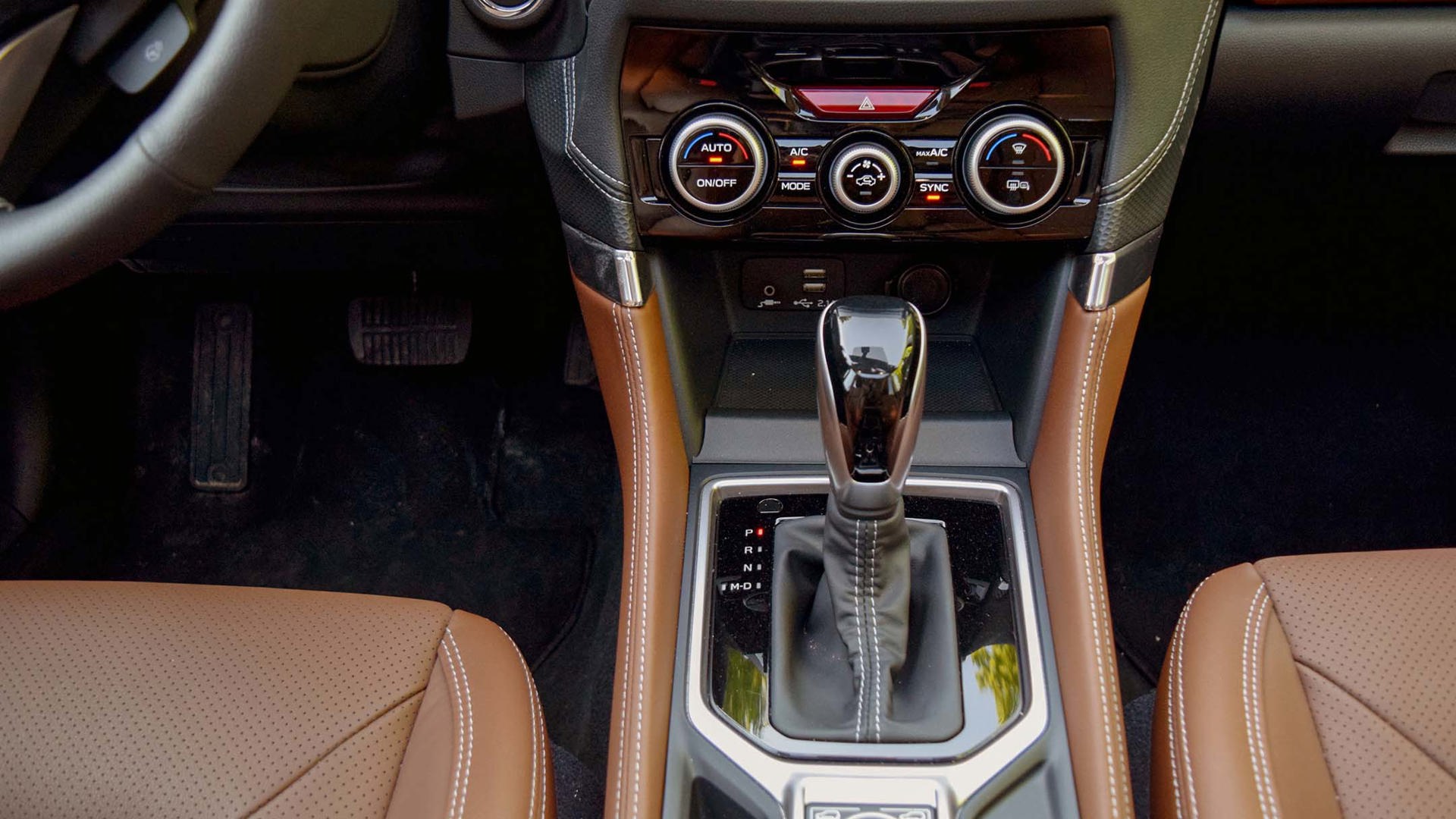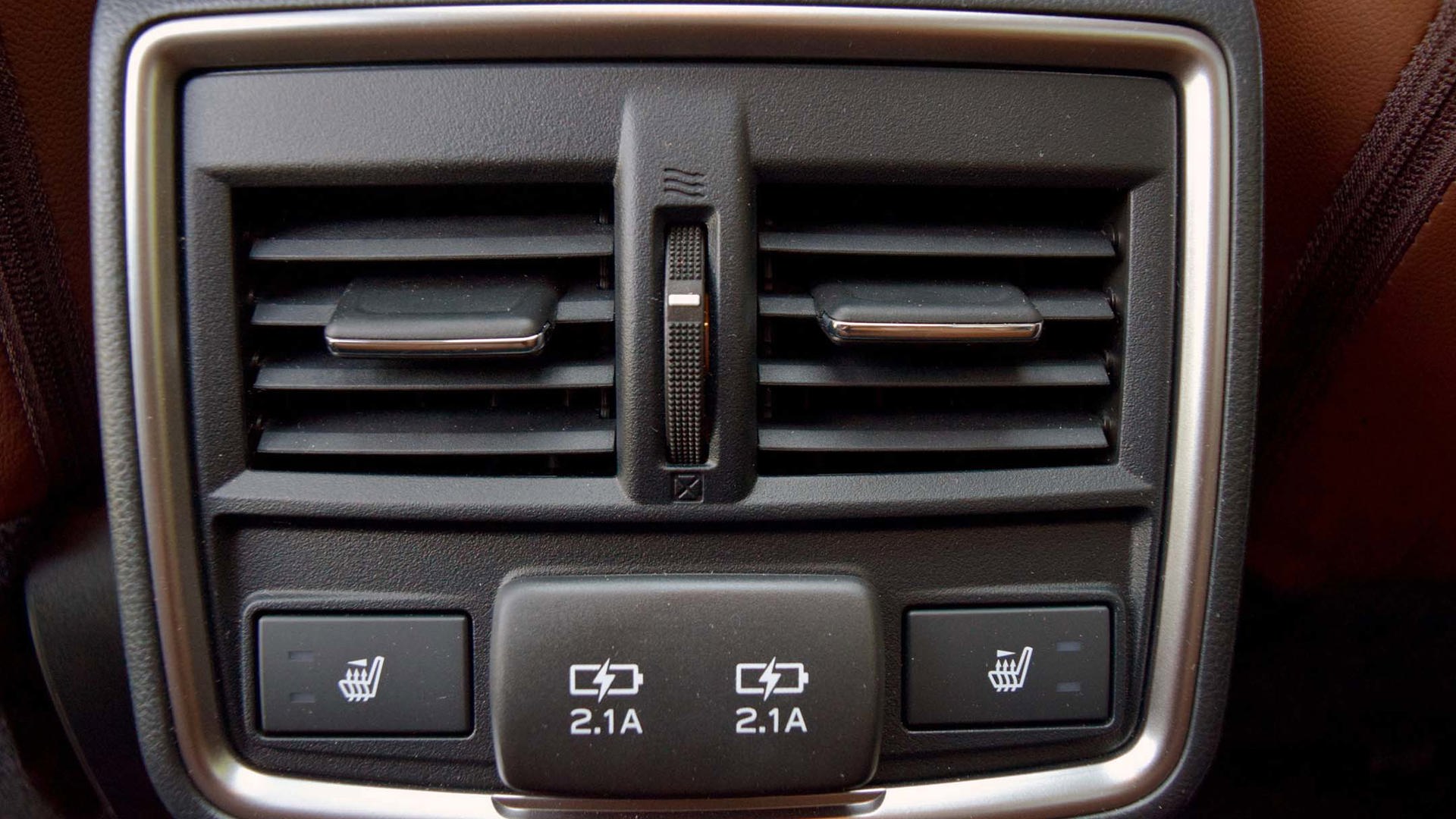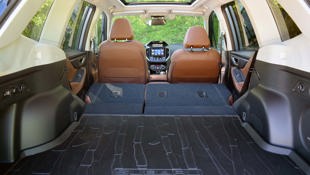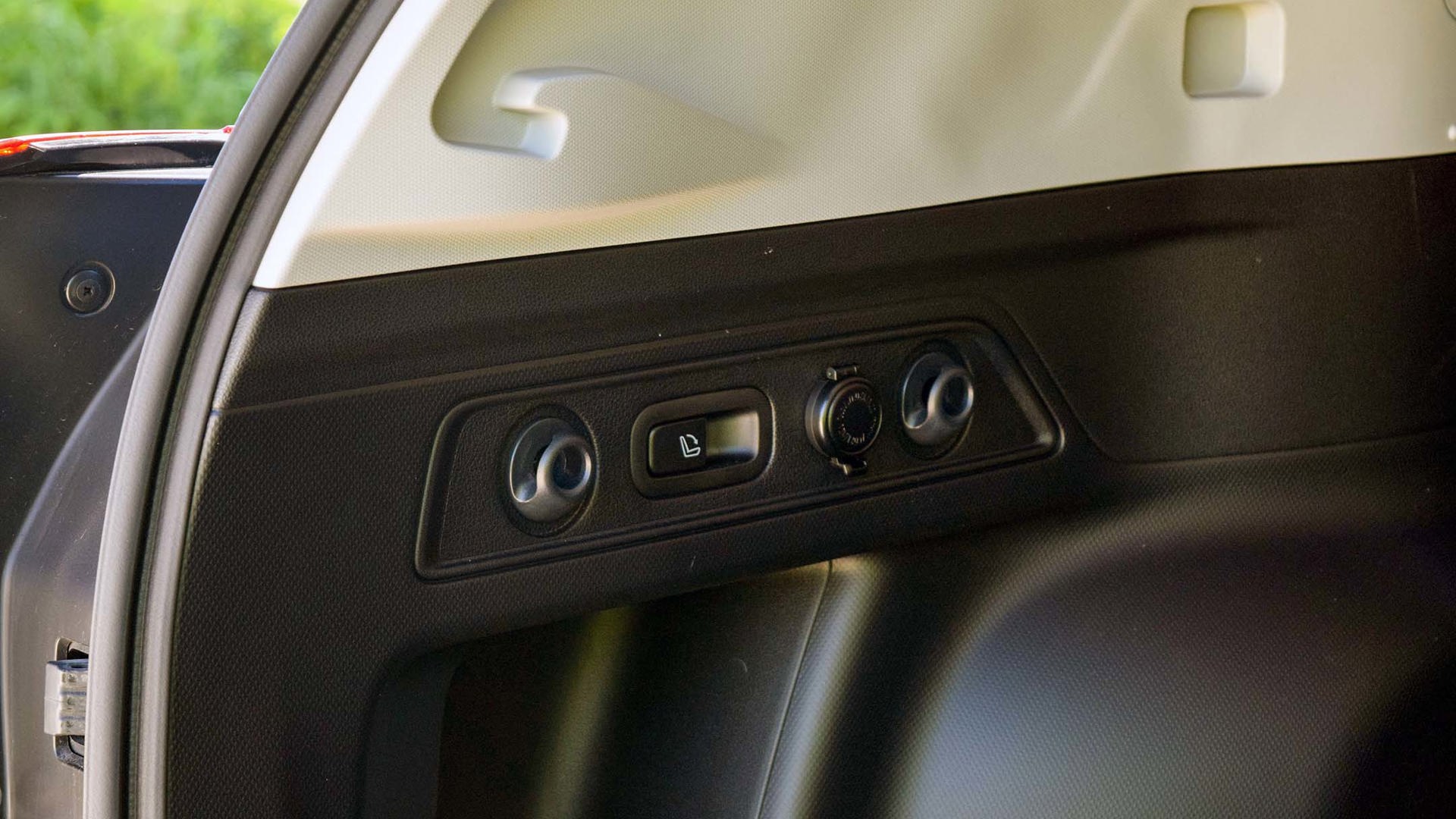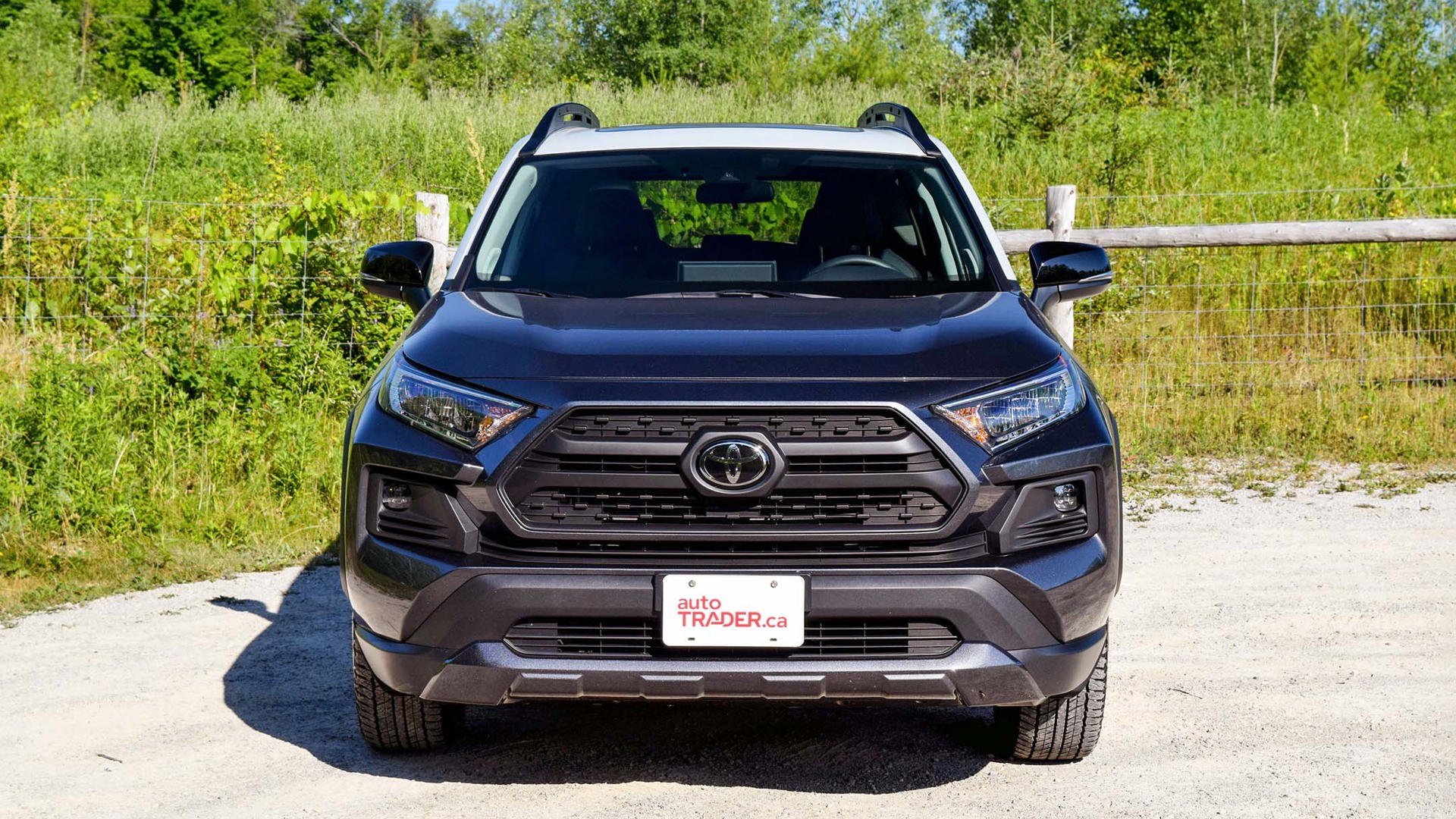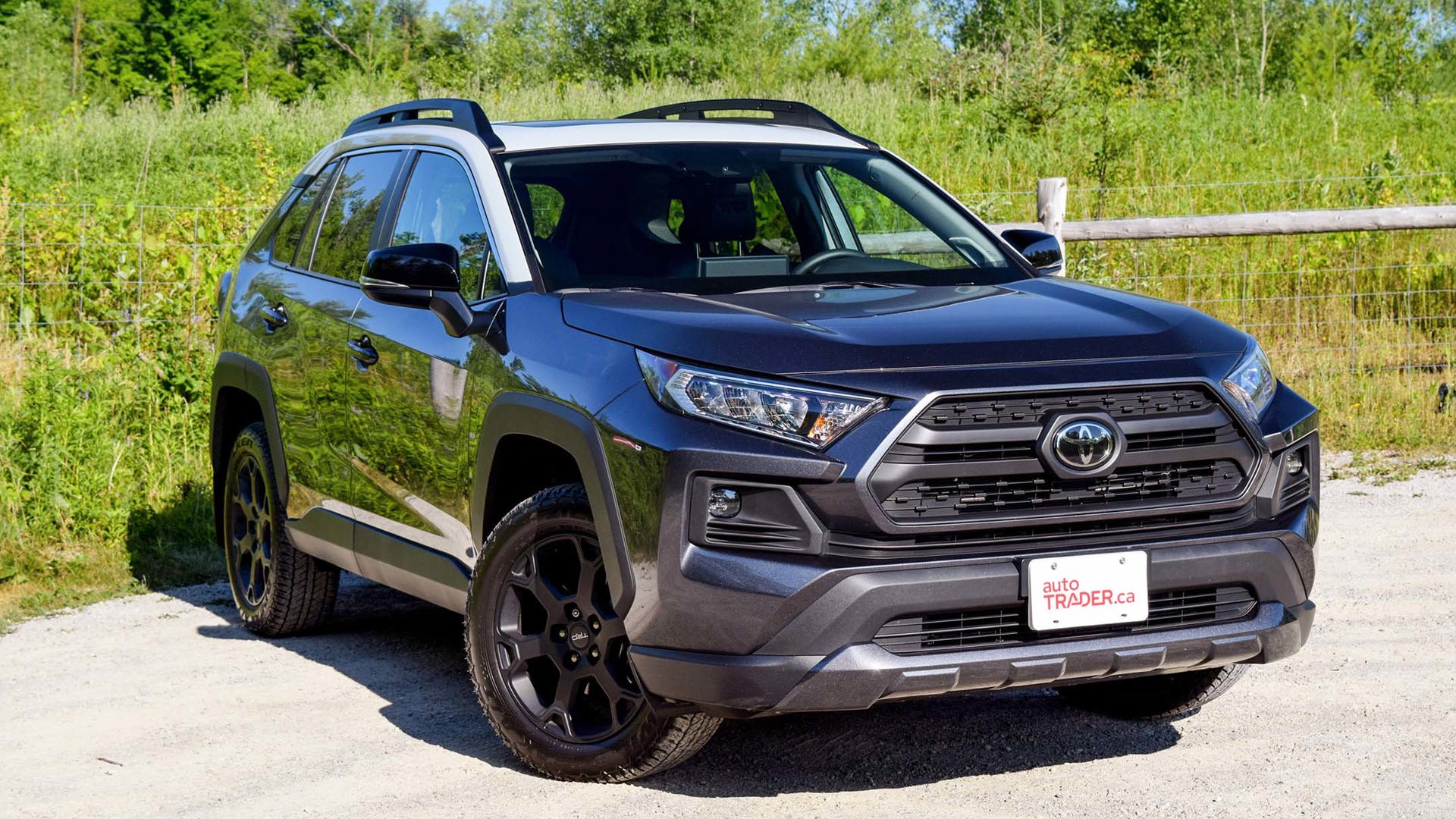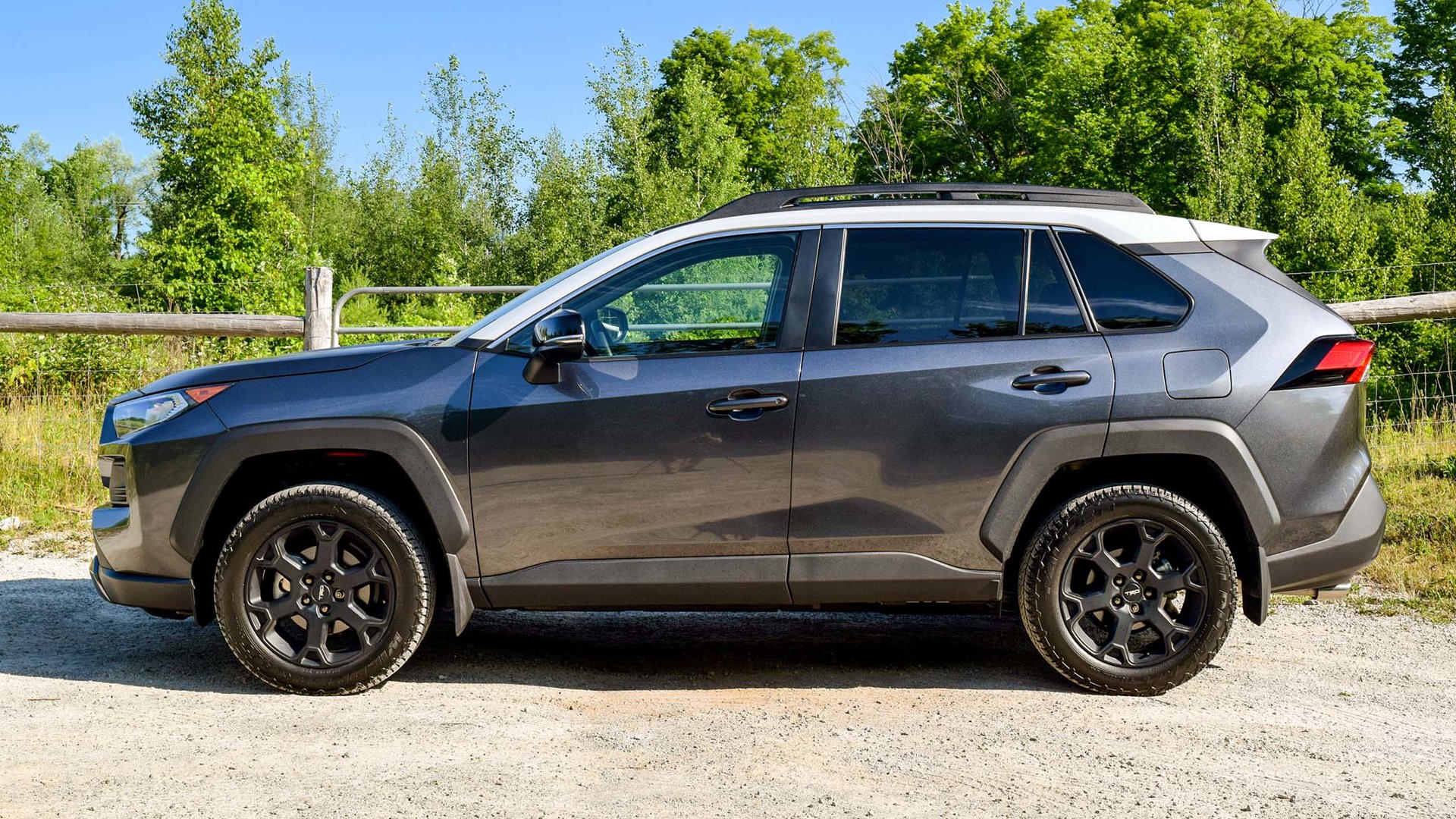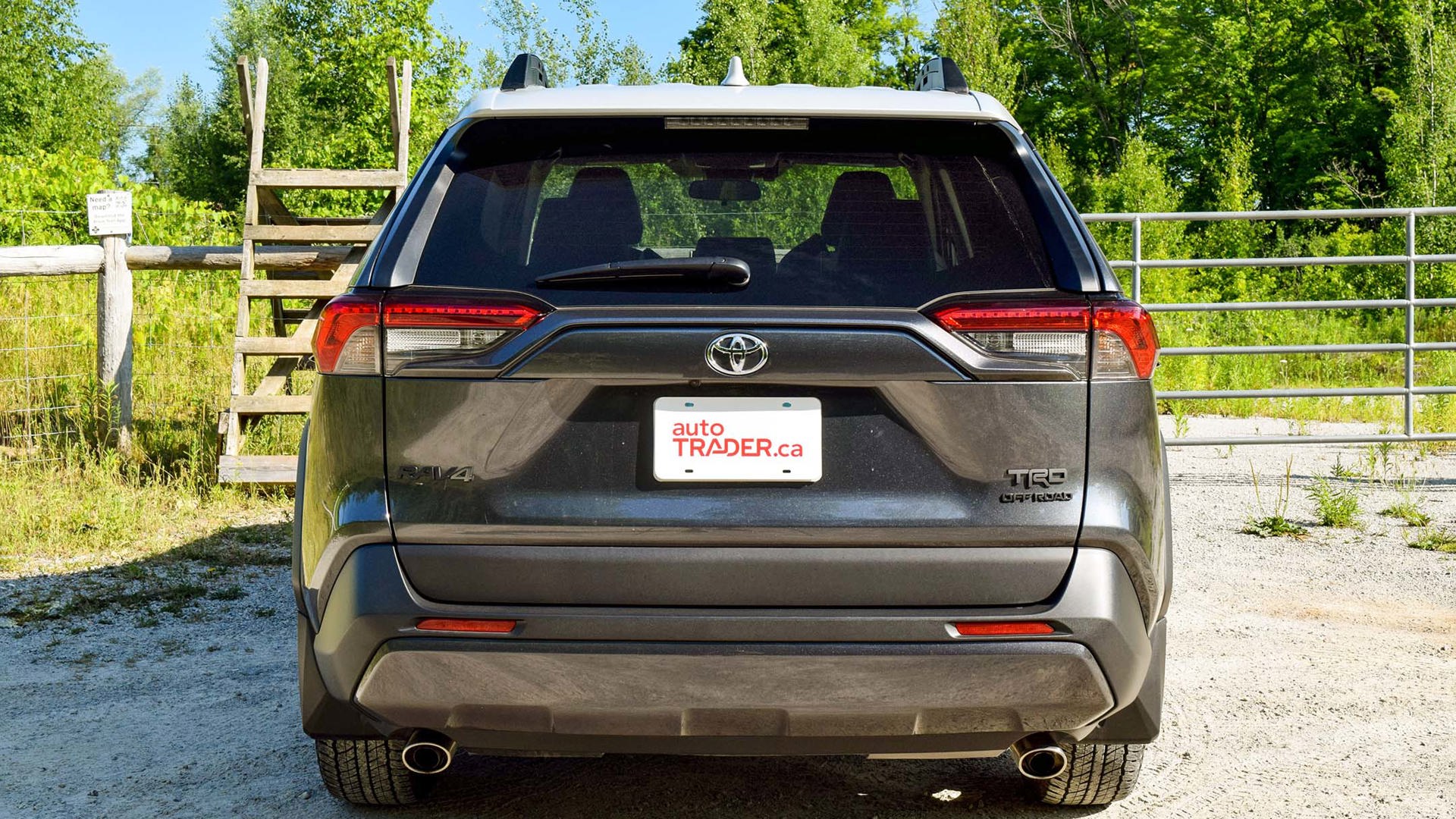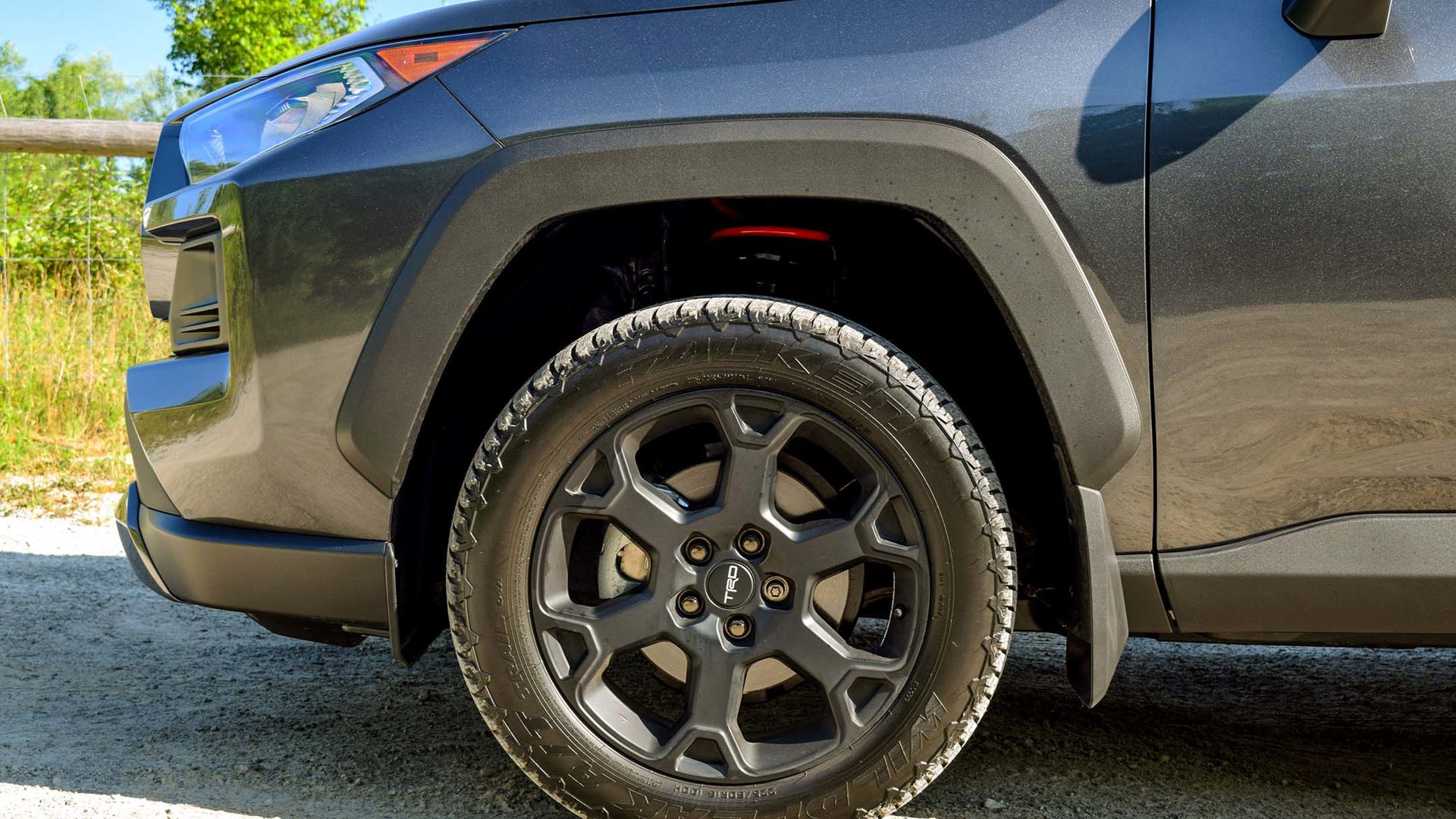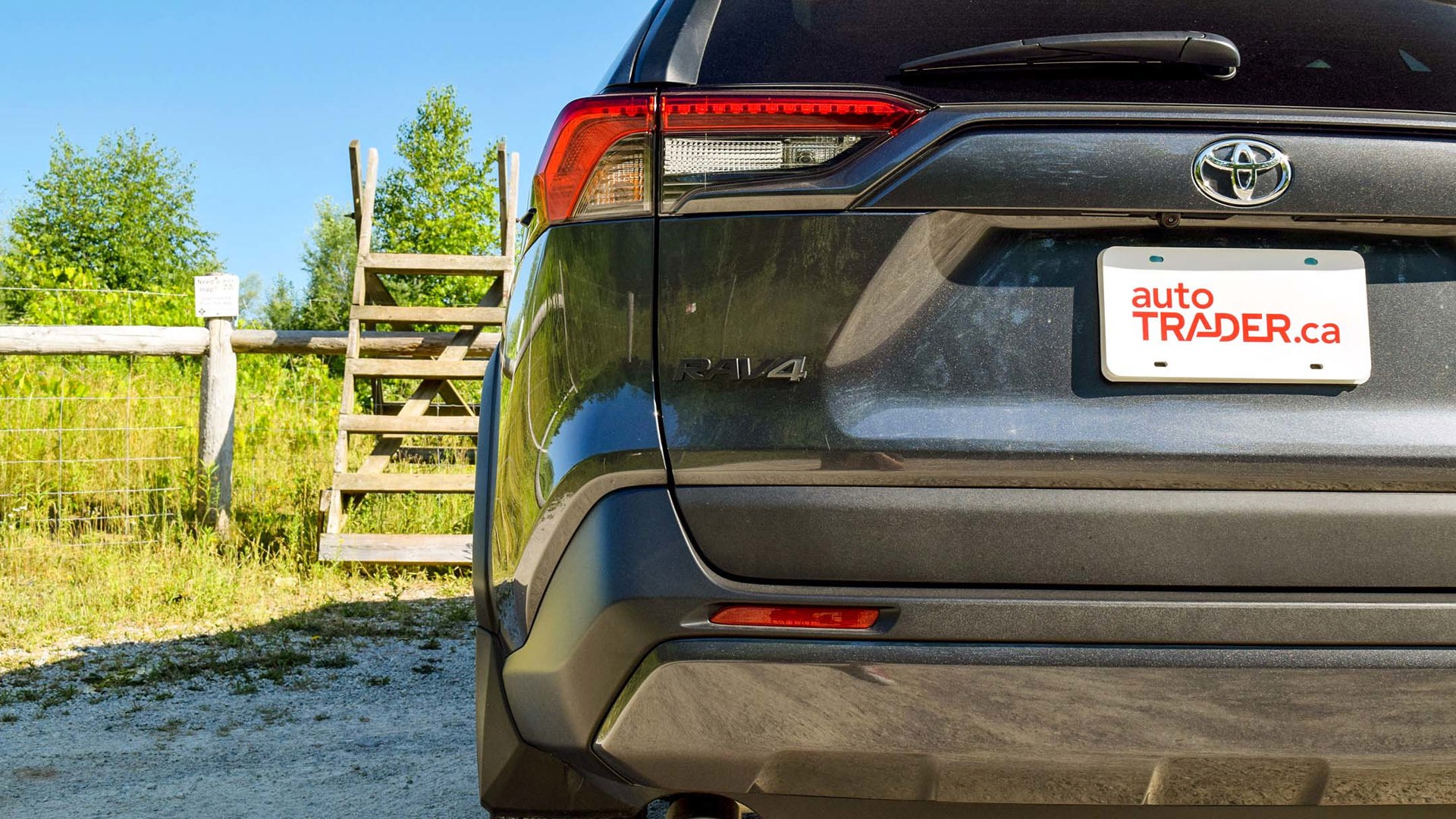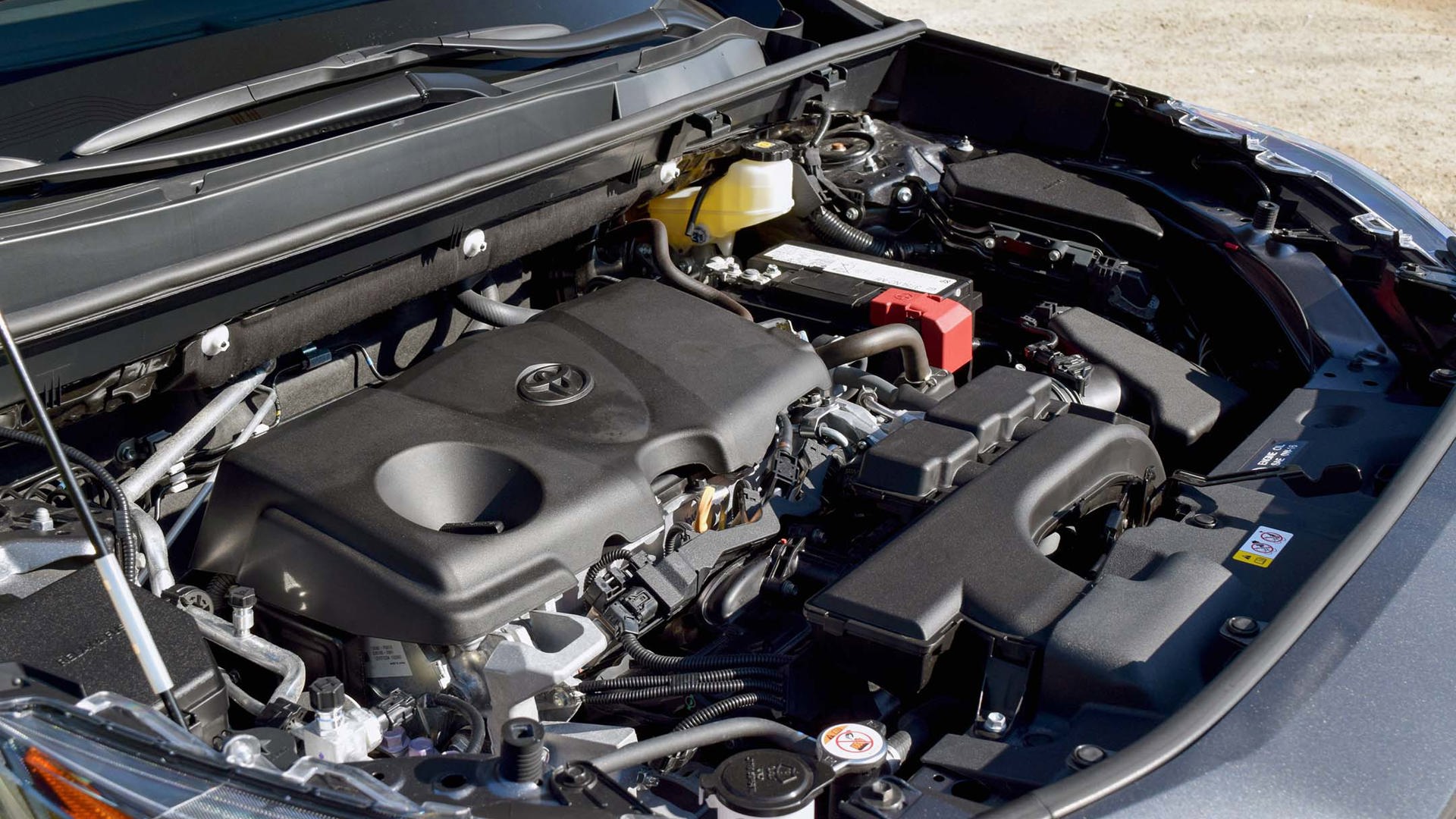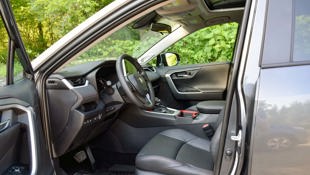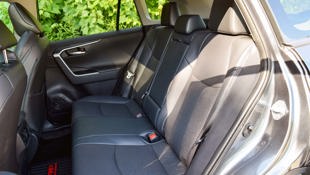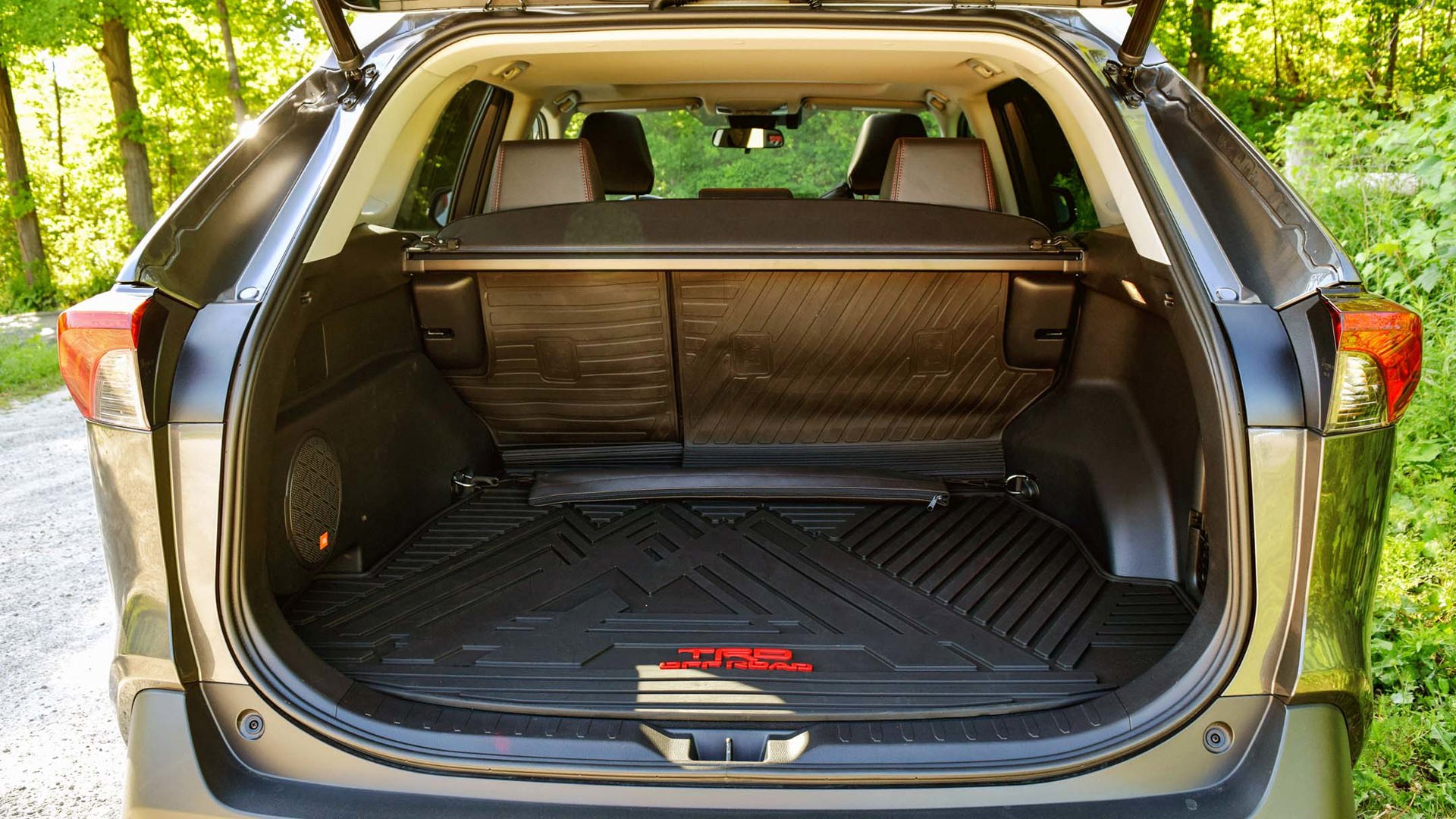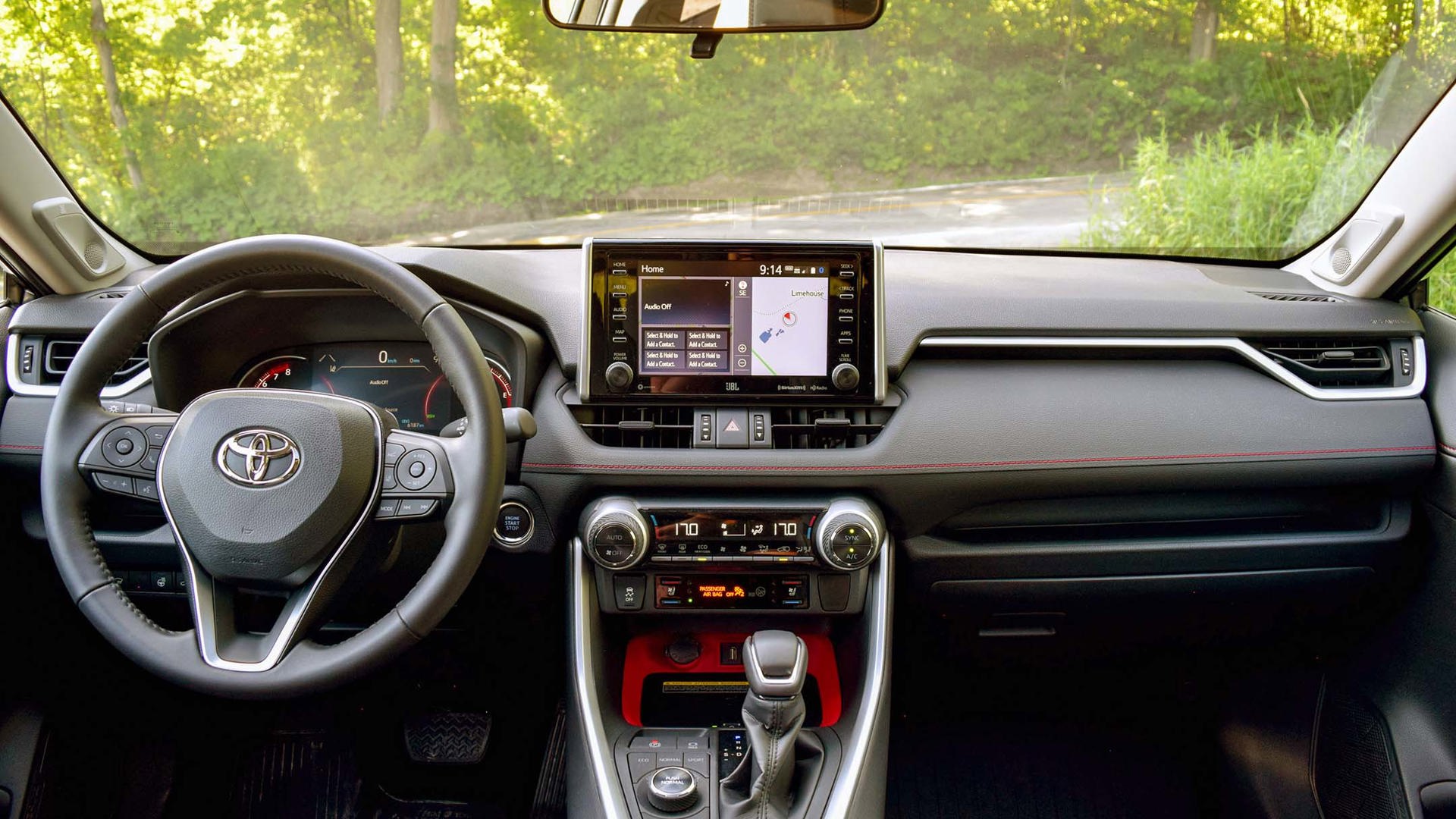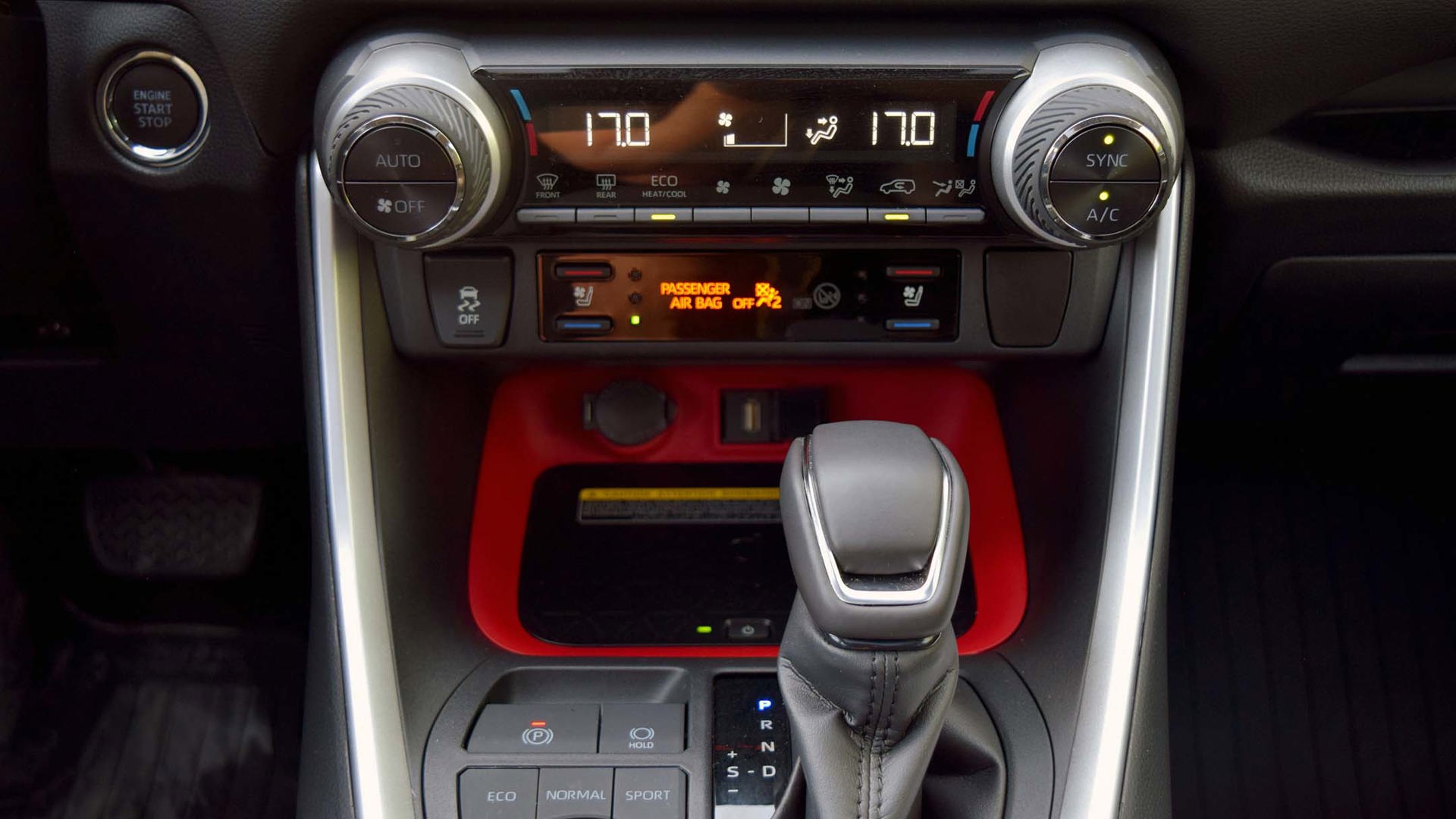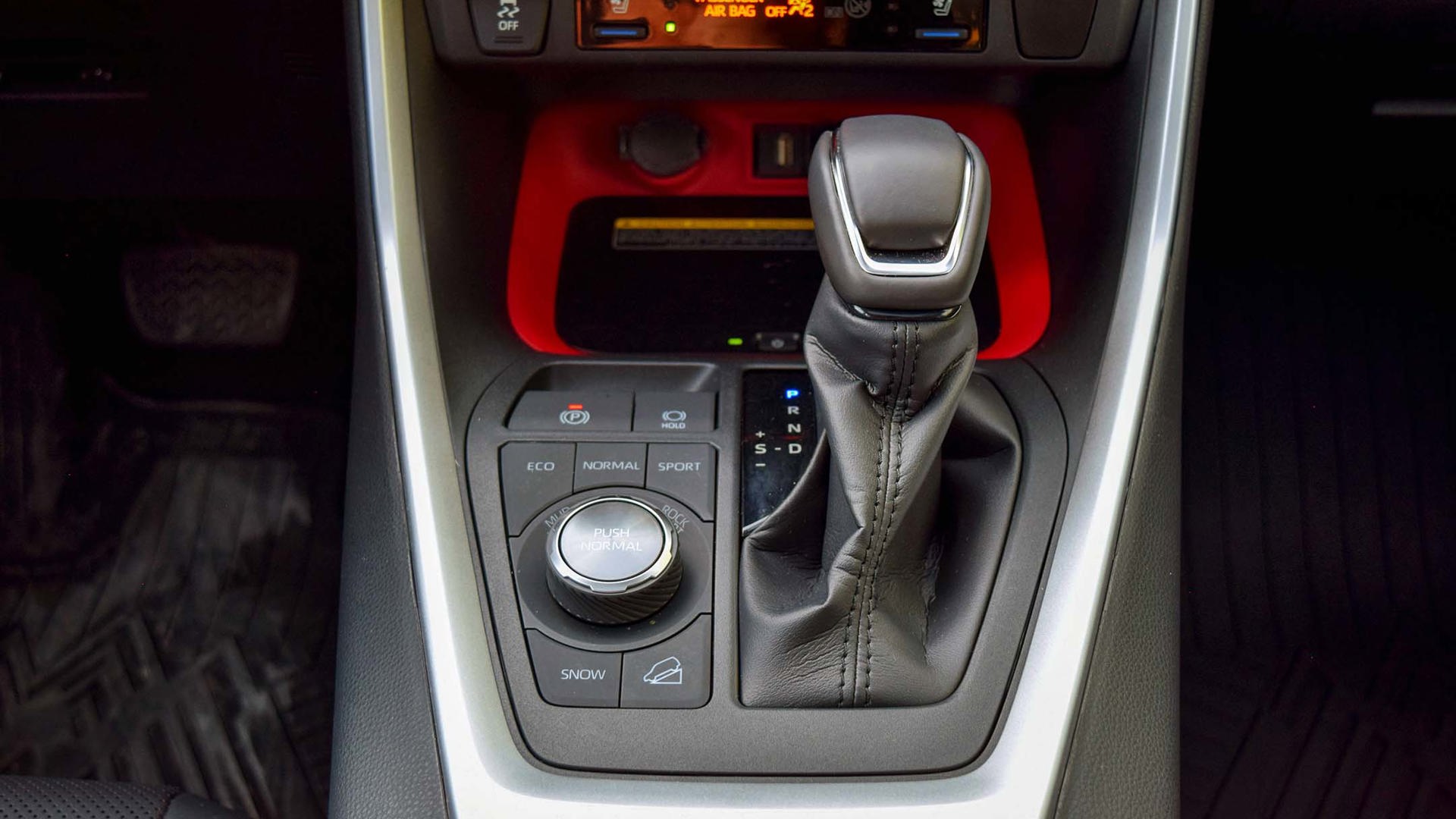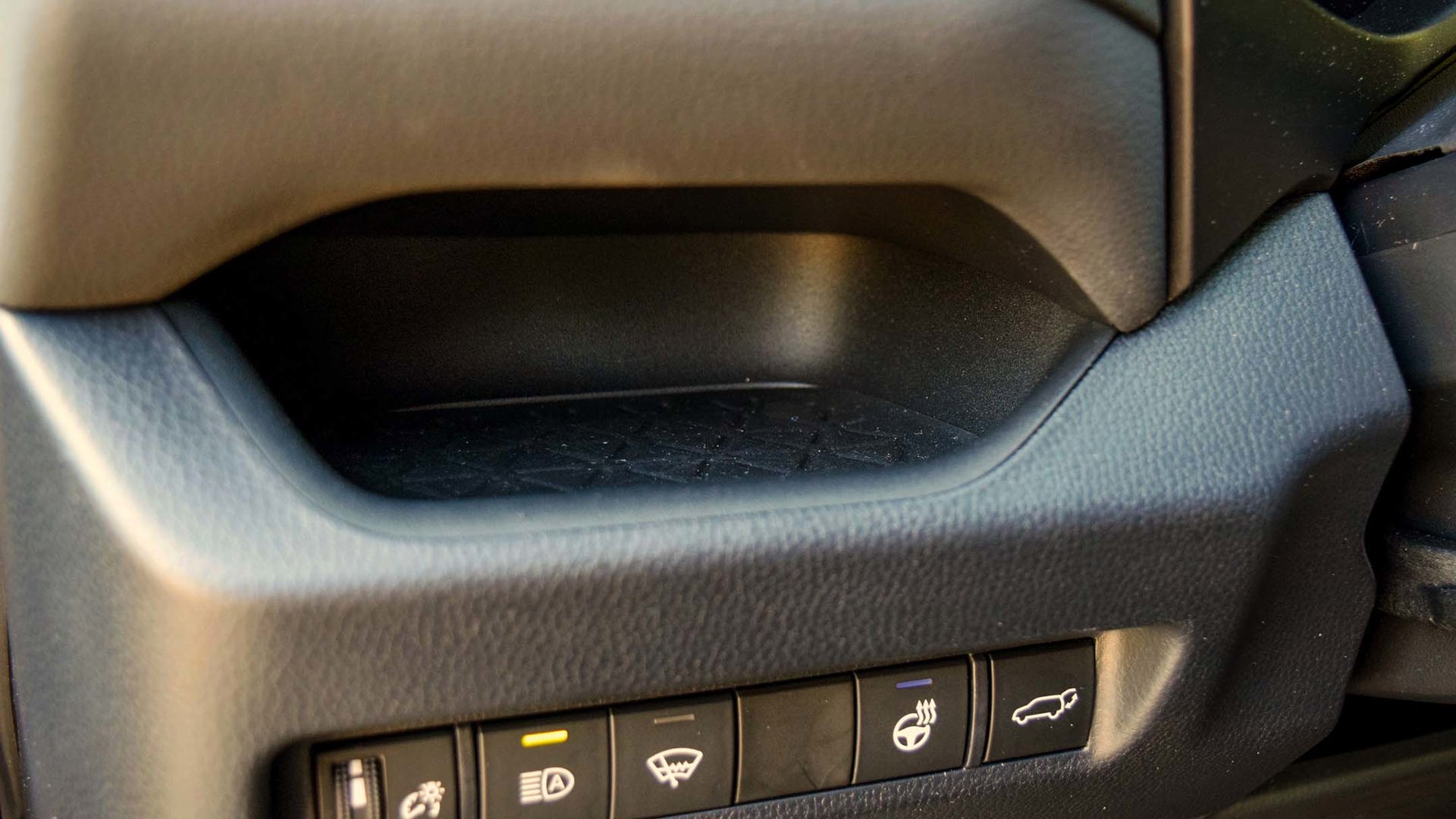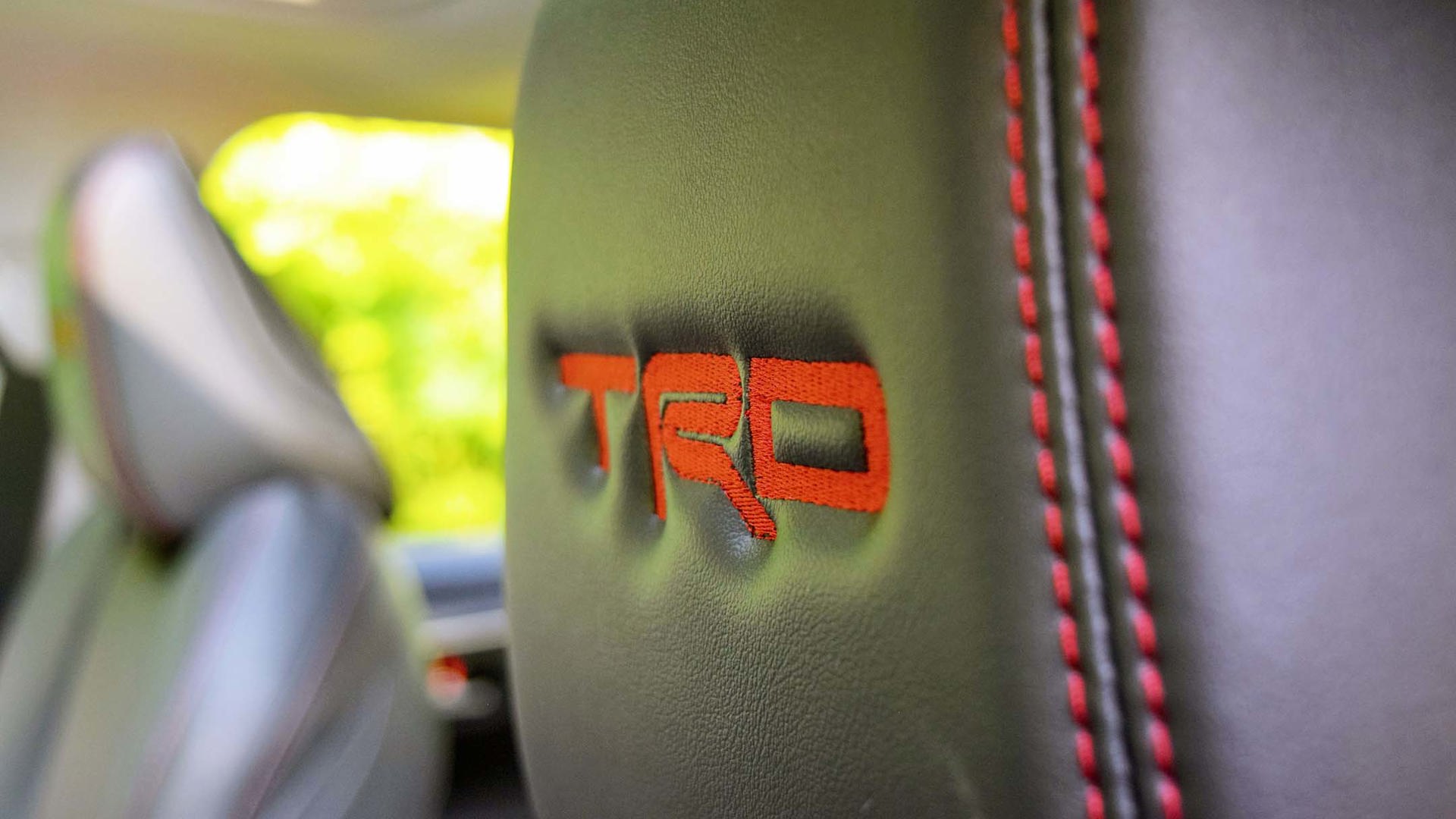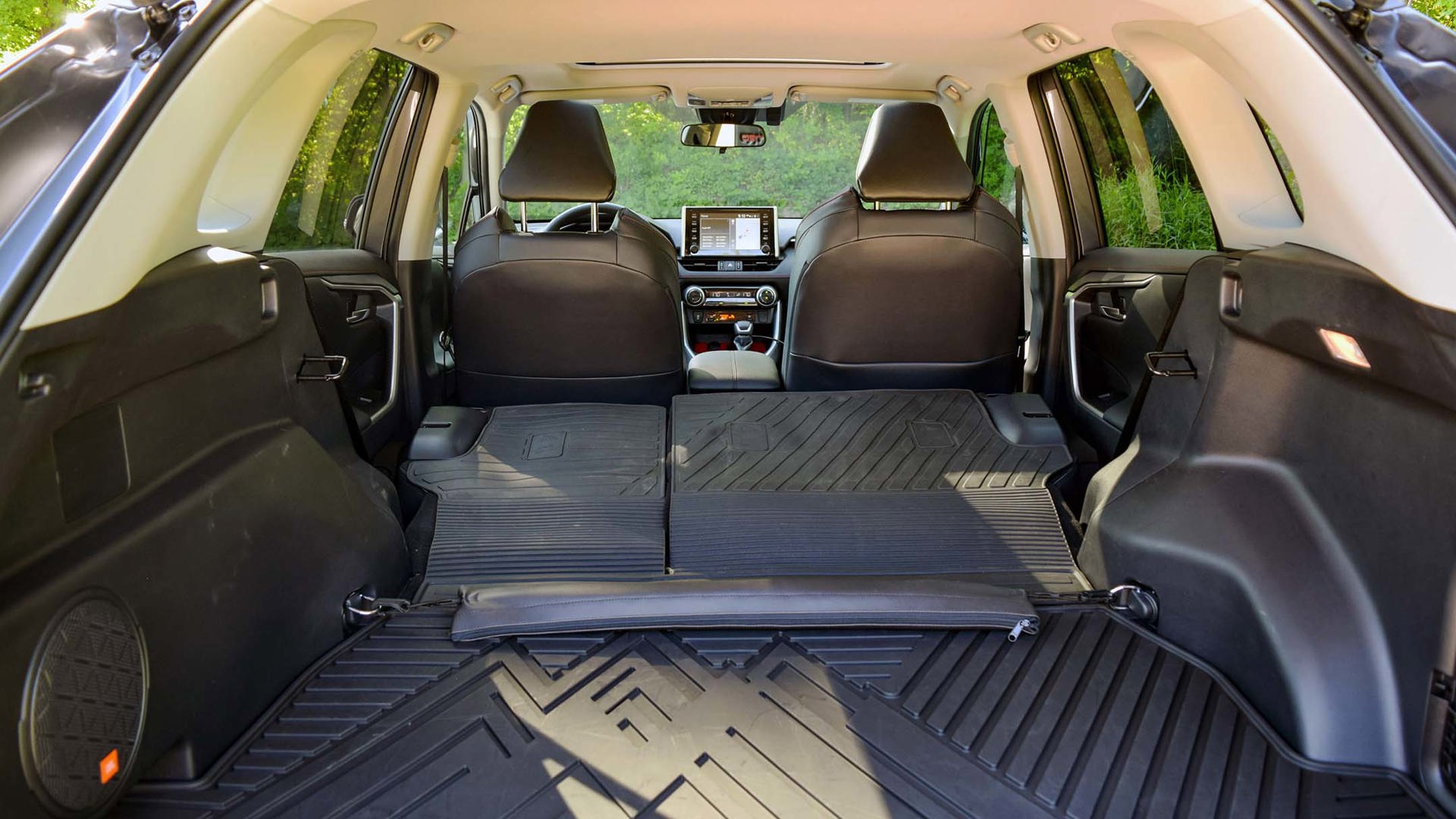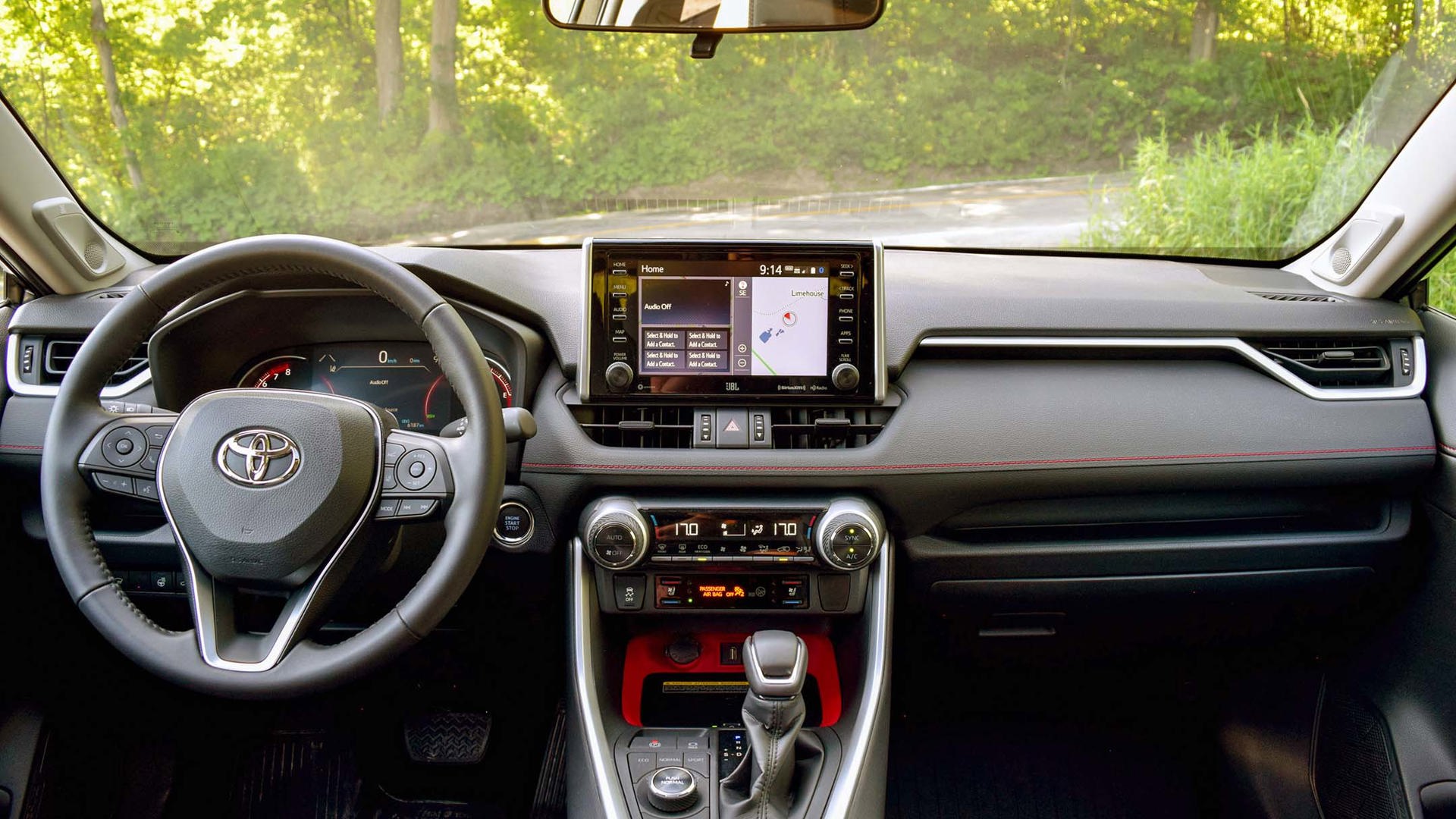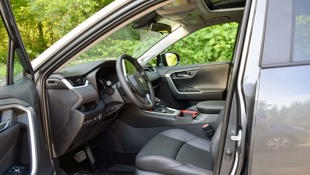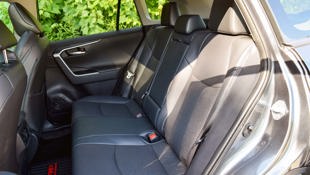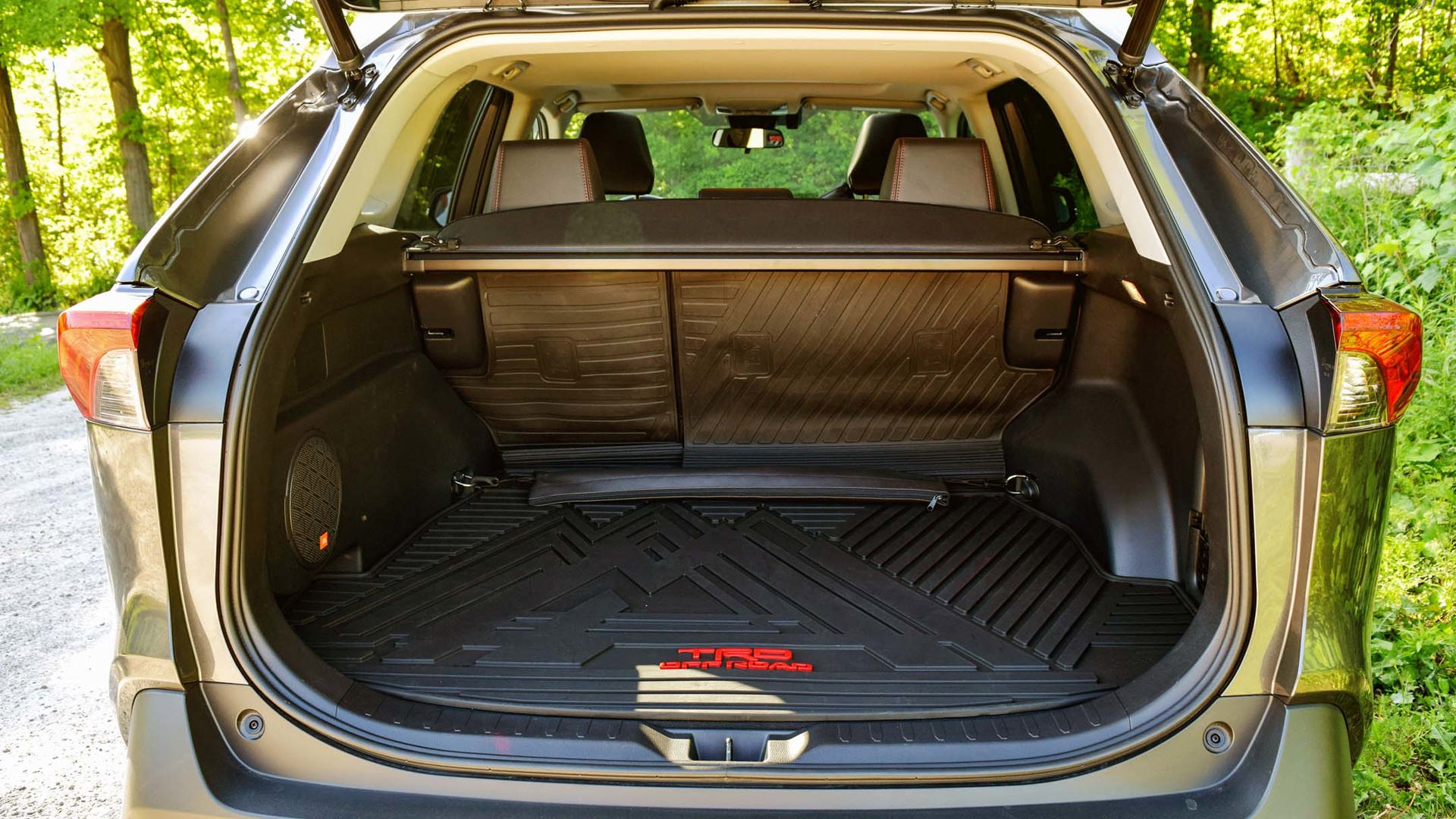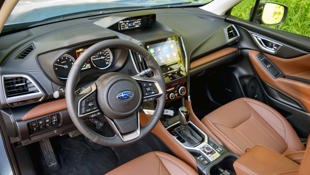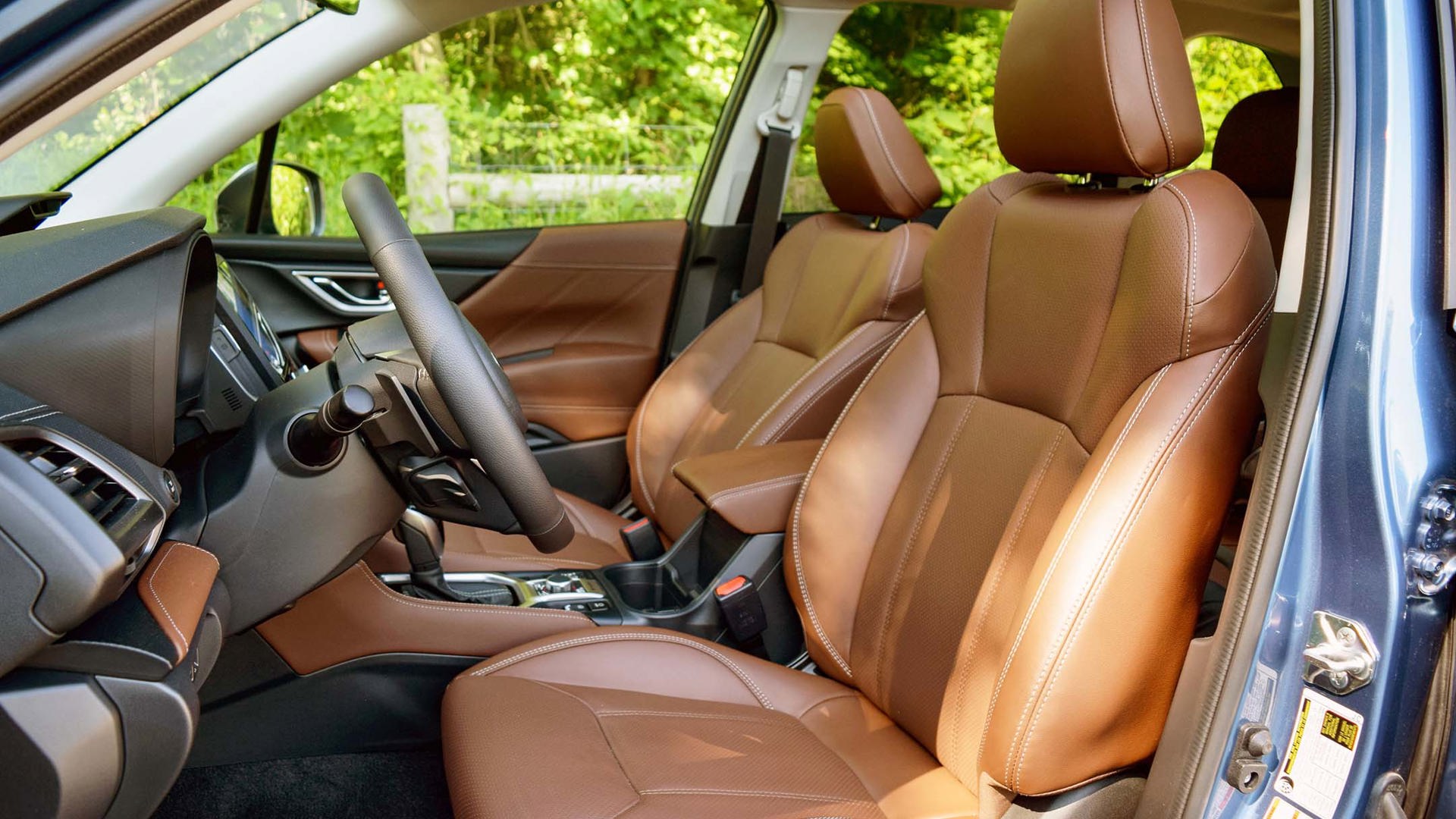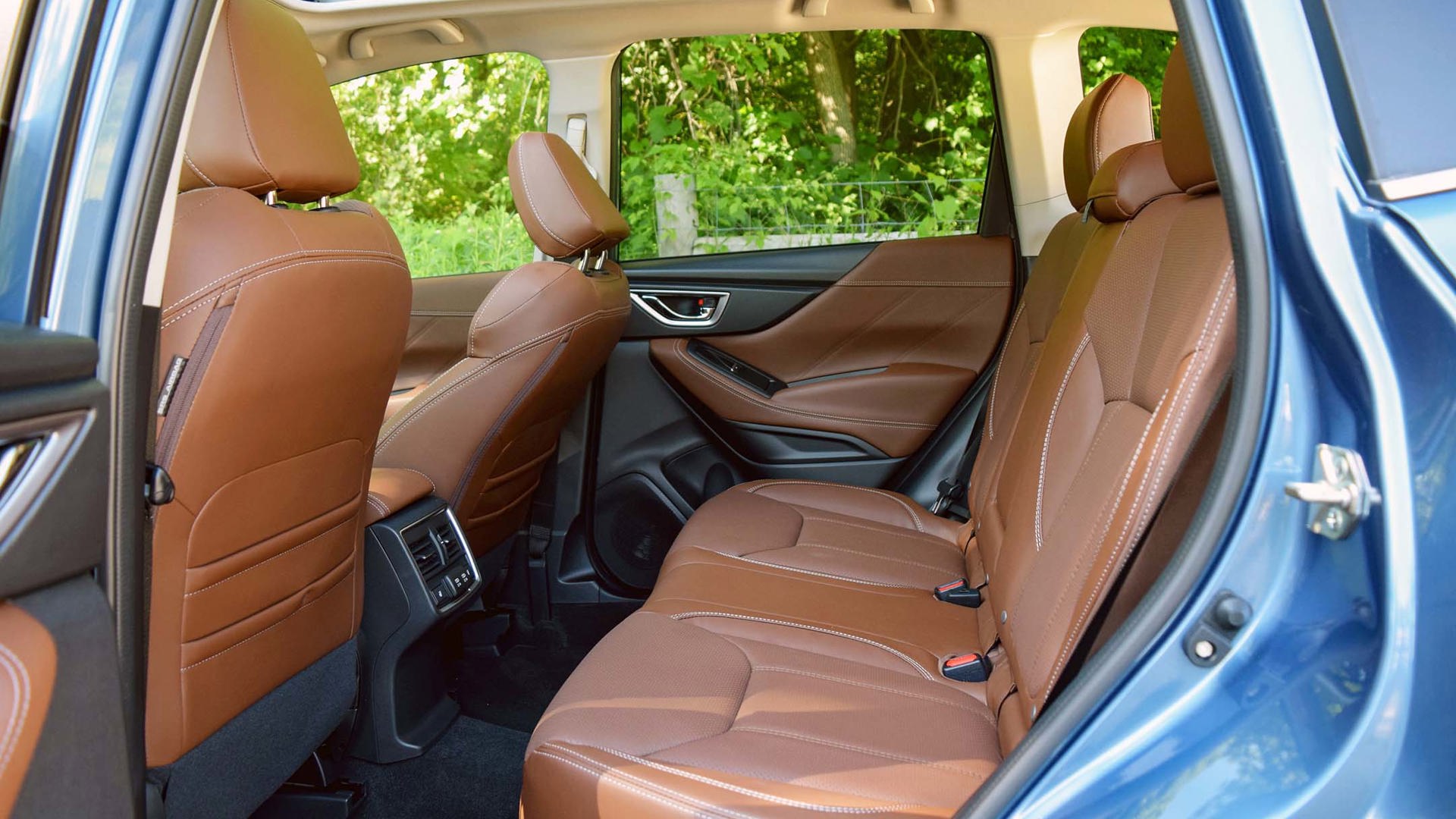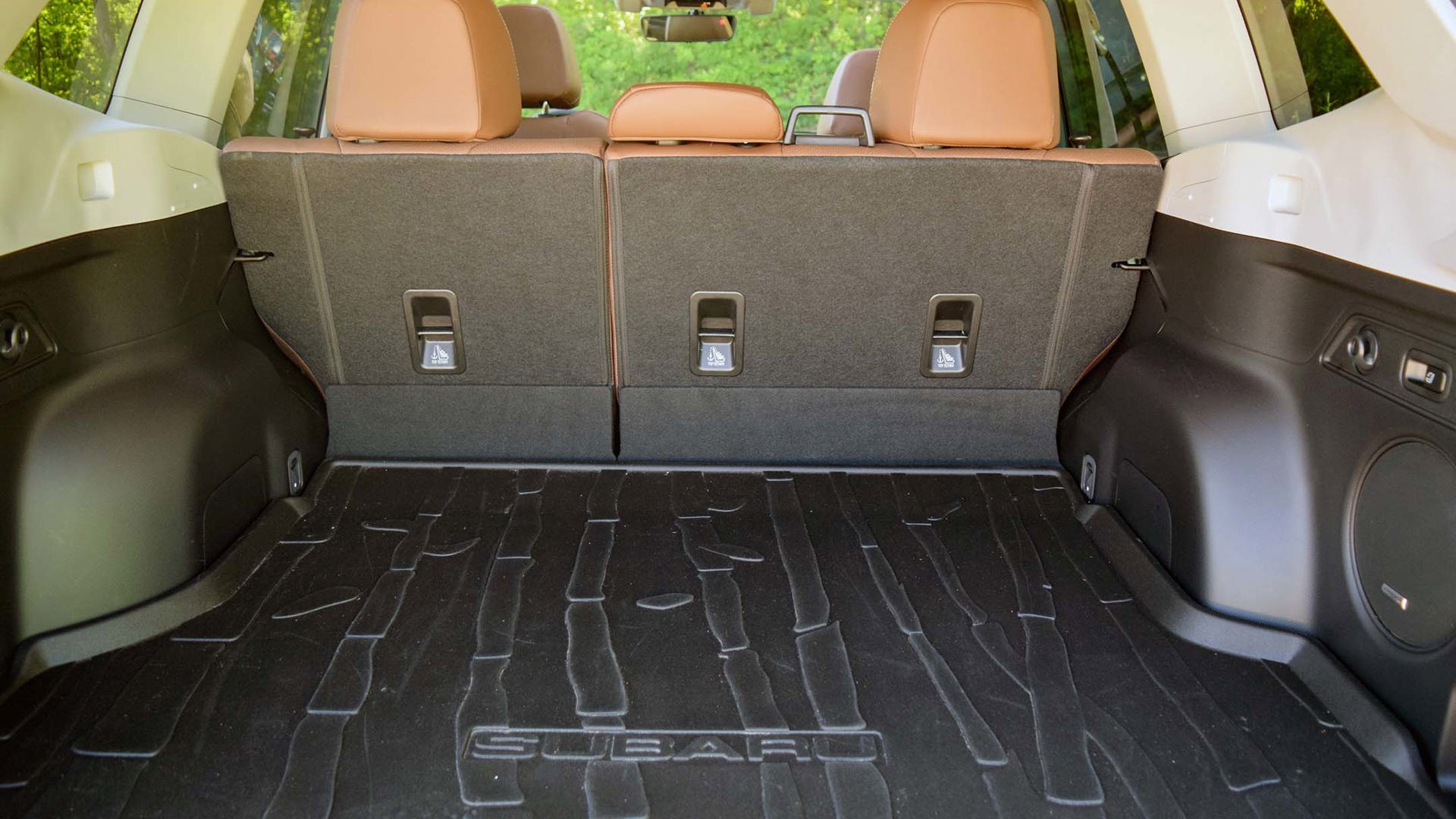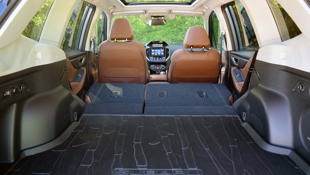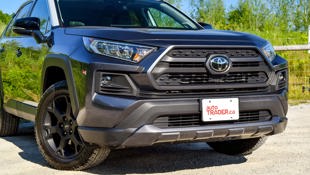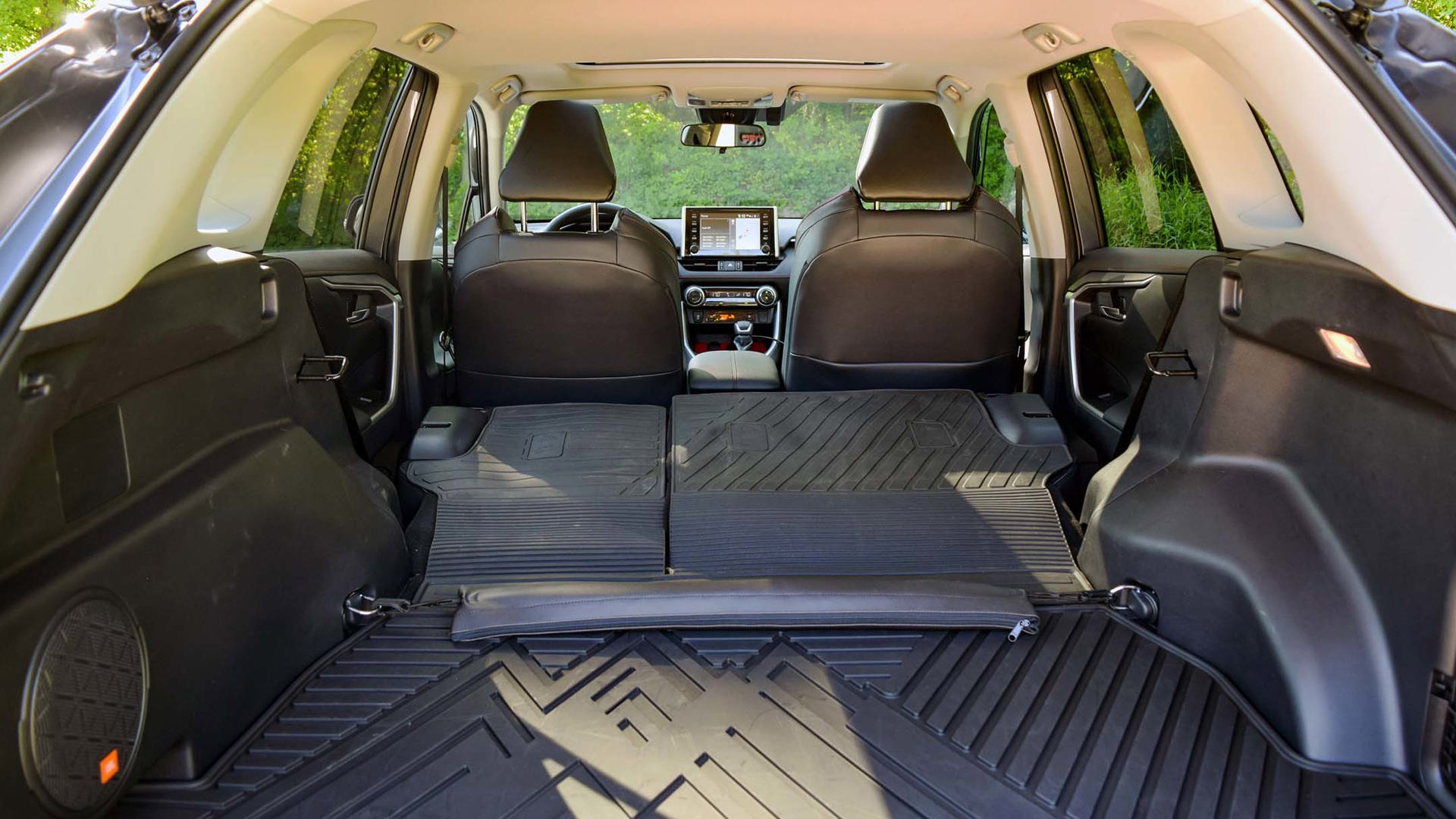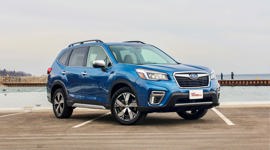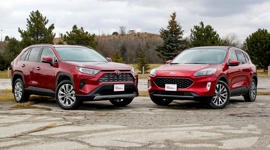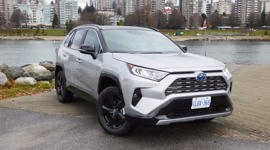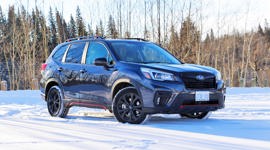Comparison Data
|
2020 Subaru Forester Premier
|
2020 Toyota RAV4 Trail
|
|---|---|
|
Engine Displacement
2.5L
|
2.5L
|
|
Engine Cylinders
H4
|
I4
|
|
Peak Horsepower
182 hp @ 5,800 rpm
|
203 hp @ 6,000 rpm
|
|
Peak Torque
176 lb-ft @ 4,400 rpm
|
184 lb-ft @ 5,500 rpm
|
|
Fuel Economy
9.0/7.2/8.2 L/100 km cty/hwy/cmb
|
9.2/7.1/8.2 L/100 km cty/hwy/cmb
|
|
Cargo Space
818/2,008 L seats down
|
1,059/1,977 L seats down
|
|
Base Price
$39,995
|
$38,890
|
|
A/C Tax
$100
|
$100
|
|
Destination Fee
$1,725
|
$1,815
|
|
Price as Tested
$42,099
|
$44,196
|
|
Optional Equipment
None
|
$3,360 – TRD Off-Road, $2,820; Magnetic Grey Paint with Ice Edge Roof, $540
|
Despite its sales success, there’s always been something forgettable about past iterations of the Toyota RAV4.
Maybe it’s been the anonymous and inoffensive design, or perhaps the drab driving style, but it’s never been especially exciting. Toyota has put considerable effort into revamping the RAV4’s milquetoast reputation in its latest incarnation, going as far as introducing an off-road-inspired TRD package.
The Subaru Forester, on the other hand, has always been something of a quirky alternative in the compact crossover segment. A plucky, go-anywhere family vehicle that boasted practicality and versatility above all else, it’s offered a certain charm despite a flawed interior and average fit and finish. The latest Forester, however, is proof of Subaru’s progress, with tons of technology, an attractive interior, and the standard all-wheel drive the brand is known for.
Exterior Styling
Where past versions have been simply dreadful in terms of exterior styling, the latest Toyota RAV4 is a stunner. Tastefully rugged, the RAV4 channels others in the Toyota lineup, leaning on the 4Runner and Tacoma for styling inspiration. The TRD Off-Road package, optional on the Trail trim, sports all-black 18-inch wheels wrapped in slightly more aggressive tires and a specially tuned suspension. For what is usually a humdrum compact crossover, this RAV4 is downright attractive.
The Forester receives none of that attention. It’s a clean design, sure, but it’s far from eye-catching or even polarizing. Maybe it’s a by-product of Subaru’s play-it-safe design approach, but where a car like the WRX is influenced by the brand’s rally heritage, none of that has trickled over to Subaru’s crossovers. The latest Forester looks a lot like its past generations, and while that may play well for the Subaru faithful, it won’t bring any new customers into the showroom on looks alone.
Toyota RAV4 Exterior Styling: 8/10
Subaru Forester Exterior Styling: 6.5/10
Interior Styling
The personality of the RAV4’s interior matches its exterior. Stitched into the headrests are TRD emblems, while there are red accents found throughout the cabin. In contrast with the Forester, the Toyota plays up its rugged-wannabe status, with big, chunky rubberized knobs and large buttons that wouldn’t look out of place in a pickup truck. Integrated into the dash is a shelf for holding a wallet or other small goodies, again with a rubberized coating to prevent slippage. Upholstery is done up in black synthetic leather with red contrast stitching to further the TRD motif.
Where the Forester’s exterior is bland and pedestrian, the interior is high-end and refined. The brown leather upholstery exudes a premium touch that’s completely out of character for Subaru – in a good way. The textured knobs feel far more high-end than the rubber used in the Toyota. The glossy black surfaces tend to attract fingerprints, however. Both vehicles do a fantastic job of shedding their past here, as the Subaru looks fancier while the Toyota boasts a more dynamic look.
Toyota RAV4 Interior Styling: 8/10
Subaru Forester Interior Styling: 8.5/10
Interior Space and Practicality
Right away, the RAV4 feels a bit cramped in terms of headroom in the front. And with about 50 mm less headroom than the Forester, anyone over six feet tall will feel the headliner encroaching their personal space. Rear headroom is on par with the Forester, and it feels about average with what’s fair to expect in this segment. Legroom is also limited compared to the Subaru as well.
The cargo area in the Forester features 818 L of room, which is less than the RAV4’s 1,064 L. Folding down the rear seats, however, leads to the Forester boasting more space, with 2,008 L of total storage compared to 1,976 L in the RAV4. The Forester has switches in the cargo area to lower the rear seats while the TRD Off-Road package in the RAV4 features a cargo floor liner that also covers the rear seatbacks so dirt doesn’t track inside when the back bench is folded to accommodate outdoor equipment.
While the RAV4 boasts that extended cargo liner in the back, a similar one is offered as an accessory in the Forester. The Subaru also features a wide step inside the rear door sills that make it much easier to access the roof rails.
Toyota RAV4 Interior Space and Practicality: 7/10
Subaru Forester Interior Space and Practicality: 7/10
Features and Technology
Both vehicles are well equipped with plenty of well-thought-out features. A dual-zone climate control system may be expected these days, but Toyota riffs on the established offerings by having systems that are more eco-friendly, or with the capability to shut off the rear-seat blowers when not necessary. The front seats have standard heat and available ventilation – the latter comes in the Trail and Limited trims – while a heated steering wheel is fitted to all but base models. The rear seats, meanwhile, come heated in the top trim only.
The eight-inch touch-screen infotainment system isn’t exactly fast, nor does it feature the prettiest graphics, but it works as needed and supports both Android Auto and Apple CarPlay. There’s also an available wireless phone charger. There’s also a power liftgate in all but base versions, and standard hill descent control and an automatic brake hold feature that keeps the brakes applied after the pedal is released – handy to have in gridlock traffic.
The Forester doesn’t offer ventilated seats, but much of the same equipment can be found inside and out. There’s dual-zone automatic climate control in all but base models, as well as standard heated seats and available heat in the rear. A heated steering wheel comes in the top two trims, while auto brake hold and hill descent control come standard.
The available sunroof is much larger than what Toyota offers, though reaching for the sunshade is a bit of a stretch, and it’s not quite a panoramic panel. The infotainment system features a large eight-inch touchscreen with Android Auto and Apple CarPlay support, and there’s an additional information screen perched on top of the dashboard for data like fuel economy or media playback details. The large on-screen buttons in the Forester are a nice touch, though sometimes the system can be a bit delayed responding to inputs.
Toyota RAV4 Features and Technology: 8/10
Subaru Forester Features and Technology: 8.5/10
Powertrain
Both crossovers feature naturally aspirated engines with 2.5L displacement, though they are executed very differently. In the Toyota, it’s an inline four-cylinder that produces 203 hp and 184 lb-ft of torque. The vehicle makes its peak figures pretty high in the rev range, and the motor doesn’t sound very pleasant as it reaches its redline. Buzzy and irritating though it may be, the good news is that the eight-speed automatic transmission tends to step in pretty quickly to change gears before it gets too annoying.
The downside is that the RAV4 never feels responsive – even in the so-called sport mode. Acceleration requires a bit of patience as the transmission completes its calculation of the best gear ratio. In addition to the expected drive modes (normal, eco, and sport), the RAV4 features a knob to tailor the drivetrain to conditions like mud, rock, sand, and snow. These settings change the way stability control activates in order for the vehicle to feel more confident in inclement weather and road conditions.
Subaru uses its tried-and-true “boxer” layout for its engine – horizontally opposed pistons that move sideways rather than vertically like in the Toyota. Featuring an output of 182 hp and 176 lb-ft of torque, the vehicle feels far more responsive and eager to get going thanks to its continuously variable transmission (CVT). While this type of transmission has been criticized for being dull to drive and irritating to hear, Subaru’s CVTs tend to be far more refined and quick to change ratios. The difference in power is hardly noticeable, and the Forester feels less lethargic even in uphill or highway scenarios. The drivetrain offers a selection of drive modes, including a perky sport setting, while the off-road-oriented X-Mode features two settings, for mild and deep stuff.
Toyota RAV4 Powertrain: 7/10
Subaru Forester Powertrain: 7.5/10
Fuel Economy
Typically, the RAV4 is pretty smart in terms of fuel usage, using up 9.2 L/100 km in the city, 7.1 on the highway, and 8.2 combined. However, opting for the TRD package pushes those figures to 9.5 in the city, 7.5 on the highway, and 8.6 combined. A RAV4 Hybrid is also available – and a plug-in hybrid is on its way – that features much more impressive fuel economy, though the TRD package can’t be added to that model.
The Forester features the same 8.2 L/100 km combined figure but arrives there by burning 9.0 L/100 km in the city and 7.2 on the highway.
Toyota RAV4 Fuel Economy: 7/10
Subaru Forester Fuel Economy: 7/10
Driving Feel
Rugged and tough-looking, the RAV4 completes that impression with how it drives, which isn’t always a positive experience. The tires included in the TRD package have a huge impact on how the RAV4 reacts to steering and braking inputs, and the drive on the pavement can be safely called unimpressive. Despite the off-road billing, the RAV4 doesn’t feel too stiff or uncomfortable, and certainly won’t get bullied on imperfect roads, but there’s nothing exceptional about the drive either. This is a bit of a letdown, as the RAV4 uses the same architecture as other surprisingly fun-to-drive Toyotas like the Corolla and Camry but doesn’t feel nearly as engaging. Add in the comparatively sluggish powertrain and it makes for an average effort that doesn’t further the RAV4’s status in this segment.
The Forester may not boast all the same off-road goodies as the RAV4 we tested, but it’s still plenty capable in most gravel, mud, and snow-covered conditions, especially thanks to that X-Mode setting. However, what makes the Forester stand out is how responsive and agile it feels. Steering is met with sharp changes of direction, even when the road isn’t dry or free of debris, and the throttle response is good, too. Furthermore, the Forester is slightly quieter on the road than the RAV4, advancing that refined feel that Subaru is chasing. The braking was the biggest complaint, feeling almost like the vehicle had gone through a track day before our test, and stops required far more pressure than expected.
Toyota RAV4 Driving Feel: 7/10
Subaru Forester Driving Feel: 8.5/10
Safety
Both vehicles are loaded with safety features including automatic high-beams, blind-spot monitoring, adaptive cruise control, and lane-keeping assistance. Both have also proven to be pretty strong in Insurance Institute for Highway Safety (IIHS) crash testing, with the RAV4 bringing home the Top Safety Pick rating, and the Forester delivering the Top Safety Pick+ rating.
However, these safety features in practice can be a bit much, especially in the Forester which also features a driver-facing camera that will remind drivers to keep their eyes on the road. Indeed, this is a necessary feature these days, but the beeping and nagging can be demoralizing and detract from the driving experience at times. The RAV4’s implementation of its safety features felt more like an assist than the harsh tones from the Forester.
Toyota RAV4 Safety: 8/10
Subaru Forester Safety: 8.5/10
Value
The RAV4 can be had at a reasonable price of $28,080 before the $1,815 freight charge, but that’s for the base front-wheel drive LE model; adding all-wheel drive brings the price up to $30,190. Stepping into the XLE model costs $31,690 – or $33,790 for the all-wheel drive variant – which is also offered with a $2,800 premium package. The $38,890 Trail model and $41,250 Limited model both come with all-wheel drive, while the TRD Off-Road Package is a $2,820 add-on to the Trail.
The Forester comes standard with all-wheel drive, so base models are a bit more expensive at $28,695 before the $1,725 freight charge. The Convenience model comes in at $32,295, while the Touring is priced at $33,895. The eye-catching Sport model is $35,495, and the Limited rings in at $38,195. The fully loaded Premier comes in at $39,995, which means the Forester never feels like a bargain compared to the RAV4. While there are plenty of models to choose from between the two, they offer similar levels of equipment without a significant price difference.
Toyota RAV4 Value: 7/10
Subaru Forester Value: 7/10
The Verdict
While there’s no doubt that the momentum Toyota has built over the years will continue with this latest RAV4, the automaker hasn’t forgotten about appealing to a new customer with models like the Trail, not to mention the TRD Off-Road pack. Rugged and tough, this probably isn’t the bland and boring crossover you were expecting. However, the Forester remains the better overall vehicle, featuring enough soft-roading credibility to go with an interior that’s been improved beyond its competition. The Subaru feels far more engaging and responsive on the road and sports innovative safety features to complete the package.
Toyota RAV4 Total: 67
Subaru Forester Total: 69
